 | ÐлекÑÑоннÑй компоненÑ: ADSP-2191 | СкаÑаÑÑ:  PDF PDF  ZIP ZIP |
Äîêóìåíòàöèÿ è îïèñàíèÿ www.docs.chipfind.ru
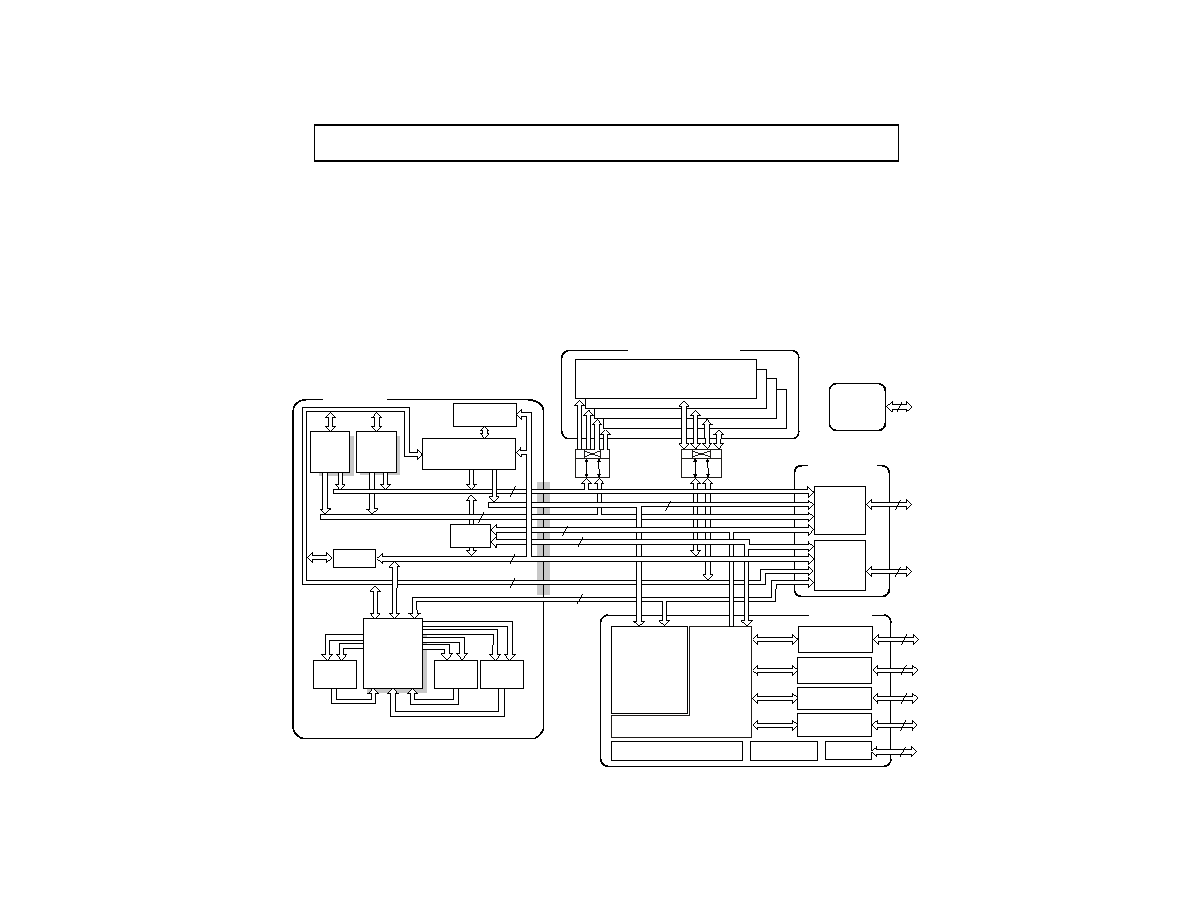
a
DSP Microcomputer
Information furnished by Analog Devices is believed to be accurate and
reliable. However, no responsibility is assumed by Analog Devices for its
use, nor for any infringements of patents or other rights of third parties that
may result from its use. No license is granted by implication or otherwise
under any patent or patent rights of Analog Devices.
One Technology Way, P.O.Box 9106, Norwood, MA 02062-9106, U.S.A.
Tel:781/329-4700 www.analog.com
Fax:781/326-8703
©
Analog Devices, Inc., 2002
REV. 0
ADSP-2191M
PERFORMANCE FEATURES
6.25 ns Instruction Cycle Time, for up to 160 MIPS
Sustained Performance
ADSP-218x Family Code Compatible with the Same
Easy to Use Algebraic Syntax
Single-Cycle Instruction Execution
Single-Cycle Context Switch between Two Sets of Com-
putation and Memory Instructions
Instruction Cache Allows Dual Operand Fetches in Every
Instruction Cycle
Multifunction Instructions
Pipelined Architecture Supports Efficient Code
Execution
Architectural Enhancements for Compiled C and C++
Code Efficiency
Architectural Enhancements beyond ADSP-218x Family
are Supported with Instruction Set Extensions for
Added Registers, and Peripherals
Flexible Power Management with User-Selectable
Power-Down and Idle Modes
FUNCTIONAL BLOCK DIAGRAM
DATA
ADDRESS
B
L
O
C
K
3
DATA
ADDRESS
B
L
O
C
K
2
2
SYSTEM INTERRUPT CONTROLLER
I/O DATA
SERIAL PORTS
(3)
SPI PORTS
(2)
18
I/O REGISTERS
(MEMORY-MAPPED)
CONTROL
STATUS
BUFFERS
I/O PROCESSOR
CACHE
64
24-BIT
JTAG
TEST &
EMULATION
6
ADDR BUS
MUX
DATA BUS
MUX
16
22
PM ADDRESS BUS
DM ADDRESS BUS
PM DATA BUS
DM DATA BUS
PX
24
16
ADSP-219x
DSP CORE
PROGRAM
SEQUENCER
DATA
REGISTER
FILE
MULT
BARREL
SHIFTER
ALU
UART PORT
(1)
DMA
CONTROLLER
6
INPUT
REGISTERS
RESULT
REGISTERS
16
16-BIT
HOST PORT
24
DAG1
4
4
16
DAG2
4
4
16
INTERNAL MEMORY
24
24
ADDRESS
B
L
O
C
K
1
DATA
DATA
ADDRESS
B
L
O
C
K
0
24 BIT
16 BIT
16 BIT
FOUR INDEPENDENT BLOCKS
PROGRAMMABLE
FLAGS (16)
TIMERS (3)
3
DMA
CONNECT
DMA ADDRESS
EXTERNAL PORT
24 BIT
18
I/O ADDRESS
24
16
24
DMA DATA

ADSP-2191M
2
REV. 0
INTEGRATION FEATURES
160 K Bytes On-Chip RAM Configured as 32K Words 24-Bit
Memory RAM and 32K Words 16-Bit Memory RAM
Dual-Purpose 24-Bit Memory for Both Instruction and
Data Storage
Independent ALU, Multiplier/Accumulator, and Barrel
Shifter Computational Units with Dual 40-bit
Accumulators
Unified Memory Space Allows Flexible Address Genera-
tion, Using Two Independent DAG Units
Powerful Program Sequencer Provides Zero-Overhead
Looping and Conditional Instruction Execution
Enhanced Interrupt Controller Enables Programming of
Interrupt Priorities and Nesting Modes
SYSTEM INTERFACE FEATURES
Host Port with DMA Capability for Glueless 8- or 16-Bit
Host Interface
16-Bit External Memory Interface for up to 16M Words of
Addressable Memory Space
Three Full-Duplex Multichannel Serial Ports, with
Support for H.100 and up to 128 TDM Channels with
A-Law and -Law Companding Optimized for Telecom-
munications Systems
Two SPI-Compatible Ports with DMA Support
UART Port with DMA Support
16 General-Purpose I/O Pins with Integrated Inter-
rupt Support
Three Programmable Interval Timers with PWM
Generation, PWM Capture/Pulsewidth Measurement,
and External Event Counter Capabilities
Up to 11 DMA Channels Can Be Active at Any Given Time
for High I/O Throughput
On-Chip Boot ROM for Automatic Booting from External
8- or 16-Bit Host Device, SPI ROM, or UART with
Autobaud Detection
Programmable PLL Supports 1 to 32 Input Frequency
Multiplication and Can Be Altered during Runtime
IEEE JTAG Standard 1149.1 Test Access Port Supports
On-Chip Emulation and System Debugging
2.5 V Internal Operation and 3.3 V I/O
144-Lead LQFP and 144-Ball Mini-BGA Packages
TABLE OF CONTENTS
GENERAL DESCRIPTION . . . . . . . . . . . . . . . . . . . . .3
DSP Core Architecture . . . . . . . . . . . . . . . . . . . . . . . .3
DSP Peripherals Architecture . . . . . . . . . . . . . . . . . . .4
Memory Architecture . . . . . . . . . . . . . . . . . . . . . . . . .5
Interrupts . . . . . . . . . . . . . . . . . . . . . . . . . . . . . . . . . .6
DMA Controller . . . . . . . . . . . . . . . . . . . . . . . . . . . . .7
Host Port . . . . . . . . . . . . . . . . . . . . . . . . . . . . . . . . . .8
DSP Serial Ports (SPORTs) . . . . . . . . . . . . . . . . . . . .9
Serial Peripheral Interface (SPI) Ports . . . . . . . . . . . . .9
UART Port . . . . . . . . . . . . . . . . . . . . . . . . . . . . . . . . 9
Programmable Flag (PFx) Pins . . . . . . . . . . . . . . . . .10
Low Power Operation . . . . . . . . . . . . . . . . . . . . . . . .10
Clock Signals . . . . . . . . . . . . . . . . . . . . . . . . . . . . . .11
Reset . . . . . . . . . . . . . . . . . . . . . . . . . . . . . . . . . . . . .11
Power Supplies . . . . . . . . . . . . . . . . . . . . . . . . . . . . .11
Booting Modes . . . . . . . . . . . . . . . . . . . . . . . . . . . . .11
Bus Request and Bus Grant . . . . . . . . . . . . . . . . . . .12
Instruction Set Description . . . . . . . . . . . . . . . . . . . .13
Development Tools . . . . . . . . . . . . . . . . . . . . . . . . . .13
Additional Information . . . . . . . . . . . . . . . . . . . . . . .15
PIN FUNCTION DESCRIPTIONS . . . . . . . . . . . . . .15
SPECIFICATIONS . . . . . . . . . . . . . . . . . . . . . . . . . . 18
ABSOLUTE MAXIMUM RATINGS. . . . . . . . . . . 19
ESD SENSITIVITY . . . . . . . . . . . . . . . . . . . . . . . . .19
Power Dissipation . . . . . . . . . . . . . . . . . . . . . . . . . . .19
TIMING SPECIFICATIONS . . . . . . . . . . . . . . . . .20
Output Drive Currents . . . . . . . . . . . . . . . . . . . . . . .41
Power Dissipation . . . . . . . . . . . . . . . . . . . . . . . . . . .41
Test Conditions . . . . . . . . . . . . . . . . . . . . . . . . . . . .41
Environmental Conditions . . . . . . . . . . . . . . . . . . . .42
144-Lead LQFP Pinout . . . . . . . . . . . . . . . . . . . . . .44
144-Lead Mini-BGA Pinout . . . . . . . . . . . . . . . . . . .46
OUTLINE DIMENSIONS . . . . . . . . . . . . . . . . . . . . .48
ORDERING GUIDE . . . . . . . . . . . . . . . . . . . . . . . . .49

3
REV. 0
ADSP-2191M
GENERAL DESCRIPTION
The ADSP-2191M DSP is a single-chip microcomputer
optimized for digital signal processing (DSP) and other high
speed numeric processing applications.
The ADSP-2191M combines the ADSP-219x family base
architecture (three computational units, two data address gener-
ators, and a program sequencer) with three serial ports, two
SPI-compatible ports, one UART port, a DMA controller, three
programmable timers, general-purpose Programmable Flag
pins, extensive interrupt capabilities, and on-chip program and
data memory spaces.
The ADSP-2191M architecture is code-compatible with DSPs
of the ADSP-218x family. Although the architectures are
compatible, the ADSP-2191M architecture has a number of
enhancements over the ADSP-218x architecture. The enhance-
ments to computational units, data address generators, and
program sequencer make the ADSP-2191M more flexible and
even easier to program.
Indirect addressing options provide addressing flexibility--
premodify with no update, pre- and post-modify by an immediate
8-bit, two's-complement value and base address registers for
easier implementation of circular buffering.
The ADSP-2191M integrates 64K words of on-chip memory
configured as 32K words (24-bit) of program RAM, and 32K
words (16-bit) of data RAM. Power-down circuitry is also
provided to reduce power consumption. The ADSP-2191M is
available in 144-lead LQFP and 144-ball mini-BGA packages.
Fabricated in a high-speed, low-power, CMOS process, the
ADSP-2191M operates with a 6.25 ns instruction cycle time
(160 MIPS). All instructions, except single-word instructions,
execute in one processor.
The ADSP-2191M's flexible architecture and comprehensive
instruction set support multiple operations in parallel. For
example, in one processor cycle, the ADSP-2191M can:
·
Generate an address for the next instruction fetch
·
Fetch the next instruction
·
Perform one or two data moves
·
Update one or two data address pointers
·
Perform a computational operation
These operations take place while the processor continues to:
·
Receive and transmit data through two serial ports
·
Receive and/or transmit data from a Host
·
Receive or transmit data through the UART
·
Receive or transmit data over two SPI ports
·
Access external memory through the external memory
interface
·
Decrement the timers
DSP Core Architecture
The ADSP-2191M instruction set provides flexible data moves
and multifunction (one or two data moves with a computation)
instructions. Every single-word instruction can be executed in a
single processor cycle. The ADSP-2191M assembly language
uses an algebraic syntax for ease of coding and readability. A
comprehensive set of development tools supports program
development.
The functional block diagram
on page 1
shows the architecture
of the ADSP-219x core. It contains three independent compu-
tational units: the ALU, the multiplier/accumulator (MAC), and
the shifter. The computational units process 16-bit data from the
register file and have provisions to support multiprecision com-
putations. The ALU performs a standard set of arithmetic and
logic operations; division primitives are also supported. The
MAC performs single-cycle multiply, multiply/add, and multi-
ply/subtract operations. The MAC has two 40-bit accumulators,
which help with overflow. The shifter performs logical and arith-
metic shifts, normalization, denormalization, and derive
exponent operations. The shifter can be used to efficiently
implement numeric format control, including multiword and
block floating-point representations.
Register-usage rules influence placement of input and results
within the computational units. For most operations, the com-
putational units' data registers act as a data register file,
permitting any input or result register to provide input to any unit
for a computation. For feedback operations, the computational
units let the output (result) of any unit be input to any unit on
the next cycle. For conditional or multifunction instructions,
there are restrictions on which data registers may provide inputs
or receive results from each computational unit. For more infor-
mation, see the ADSP-219x DSP Instruction Set Reference.
A powerful program sequencer controls the flow of instruction
execution. The sequencer supports conditional jumps, subrou-
tine calls, and low interrupt overhead. With internal loop
counters and loop stacks, the ADSP-2191M executes looped
code with zero overhead; no explicit jump instructions are
required to maintain loops.
Two data address generators (DAGs) provide addresses for
simultaneous dual operand fetches (from data memory and
program memory). Each DAG maintains and updates four
16-bit address pointers. Whenever the pointer is used to access
data (indirect addressing), it is pre- or post-modified by the value
of one of four possible modify registers. A length value and base
address may be associated with each pointer to implement
automatic modulo addressing for circular buffers. Page registers
in the DAGs allow circular addressing within 64K word bound-
aries of each of the 256 memory pages, but these buffers may not
cross page boundaries. Secondary registers duplicate all the
primary registers in the DAGs; switching between primary and
secondary registers provides a fast context switch.
Efficient data transfer in the core is achieved with the use of
internal buses:
·
Program Memory Address (PMA) Bus
·
Program Memory Data (PMD) Bus
·
Data Memory Address (DMA) Bus
·
Data Memory Data (DMD) Bus
·
DMA Address Bus
·
DMA Data Bus

ADSP-2191M
4
REV. 0
The two address buses (PMA and DMA) share a single external
address bus, allowing memory to be expanded off-chip, and the
two data buses (PMD and DMD) share a single external data
bus. Boot memory space and I/O memory space also share the
external buses.
Program memory can store both instructions and data, permit-
ting the ADSP-2191M to fetch two operands in a single cycle,
one from program memory and one from data memory. The
DSP's dual memory buses also let the ADSP-219x core fetch an
operand from data memory and the next instruction from
program memory in a single cycle.
DSP Peripherals Architecture
The functional block diagram
on page 1
shows the DSP's
on-chip peripherals, which include the external memory inter-
face, Host port, serial ports, SPI-compatible ports, UART port,
JTAG test and emulation port, timers, flags, and interrupt con-
troller. These on-chip peripherals can connect to off-chip devices
as shown in
Figure 1
.
The ADSP-2191M has a 16-bit Host port with DMA capability
that lets external Hosts access on-chip memory. This 24-pin
parallel port consists of a 16-pin multiplexed data/address bus
and provides a low-service overhead data move capability. Con-
figurable for 8 or 16 bits, this port provides a glueless interface
to a wide variety of 8- and 16-bit microcontrollers. Two
chip-selects provide Hosts access to the DSP's entire memory
map. The DSP is bootable through this port.
The ADSP-2191M also has an external memory interface that is
shared by the DSP's core, the DMA controller, and DMA
capable peripherals, which include the UART, SPORT0,
SPORT1, SPORT2, SPI0, SPI1, and the Host port. The external
port consists of a 16-bit data bus, a 22-bit address bus, and
control signals. The data bus is configurable to provide an 8 or
16 bit interface to external memory. Support for word packing
lets the DSP access 16- or 24-bit words from external memory
regardless of the external data bus width. When configured for
an 8-bit interface, the unused eight lines provide eight program-
mable, bidirectional general-purpose Programmable Flag lines,
six of which can be mapped to software condition signals.
The memory DMA controller lets the ADSP-2191M move data
and instructions from between memory spaces: internal-to-exter-
nal, internal-to-internal, and external-to- external. On-chip
peripherals can also use this controller for DMA transfers.
The ADSP-2191M can respond to up to seventeen interrupts at
any given time: three internal (stack, emulator kernel, and
power-down), two external (emulator and reset), and twelve
user-defined (peripherals) interrupts. The programmer assigns a
peripheral to one of the 12 user-defined interrupts. The priority
of each peripheral for interrupt service is determined by these
assignments.
There are three serial ports on the ADSP-2191M that provide a
complete synchronous, full-duplex serial interface. This interface
includes optional companding in hardware and a wide variety of
framed or frameless data transmit and receive modes of opera-
tion. Each serial port can transmit or receive an internal or
external, programmable serial clock and frame syncs. Each serial
port supports 128-channel Time Division Multiplexing.
The ADSP-2191M provides up to sixteen general-purpose I/O
pins, which are programmable as either inputs or outputs. Eight
of these pins are dedicated-general purpose Programmable Flag
pins. The other eight of them are multifunctional pins, acting as
general-purpose I/O pins when the DSP connects to an 8-bit
external data bus and acting as the upper eight data pins when
the DSP connects to a 16-bit external data bus. These Program-
mable Flag pins can implement edge- or level-sensitive
interrupts, some of which can be used to base the execution of
conditional instructions.
Figure 1. System Diagram
S ERIAL
DEVICE
( O P TI O N A L )
DAT A158
IOMS
ADSP-2191M
BMS
MS30
BR
BG
AC K
WR
RD
ADD R210
DAT A70
D ATA158
A DDR210
D ATA70
CS
ACK
WE
OE
EXT ERN AL
ME MO RY
( O PT I O N A L )
D ATA158
A DDR210
D ATA70
CS
ACK
WE
OE
BO OT
ME MO RY
( O PT I O N A L )
D ATA158
A DDR170
D ATA70
CS
ACK
WE
OE
E XT ER NAL
I/O MEMOR Y
( O P TI O N A L )
A
D
D
R
E
S
S
C
O
N
T
R
O
L
D
A
T
A
ADDR16
A DDR150/
D ATA150
CS1
ACK
WR
RD
HOS T
PRO CESSO R
( O P TI O N A L )
CS0
ALE
H AD150
HA16
HCMS
HCIOMS
HRD
HWR
HA CK
H ALE
HACK_P
T CLK0
T FS0
DT 0
RC LK0
RF S0
DR 0
T CLK1
T FS1
DT 1
RC LK1
RF S1
DR 1
T CLK2/S CK0
T FS2/MOSI0
DT 2/MISO 0
RC LK2/S CK1
RF S2/ MO SI1
DR 2/MIS O 1
RX D
T XD
RE SE T
JT AG
SPO RT1
SPO RT2
SPO RT0
CL KIN
XTA L
MS EL60/P F60
DF /P F7
BY PASS
BMO DE10
O P MO DE
CL KOUT
T MR20
UART
SP I0
SP I1
S ERIAL
DEV ICE
( O P T I O N A L)
S ERIAL
DEV ICE
( O P T I O N A L)
U ART
DEV ICE
( O P T I O N A L)
CLO CK
O R
CRYS TAL
T IMER
OUT OR
CAPTURE
CLO CK
MULTIPL Y
AN D
RAN GE
BO OT
AND O P
MODE
6
BGH

5
REV. 0
ADSP-2191M
Three programmable interval timers generate periodic inter-
rupts. Each timer can be independently set to operate in one of
three modes:
·
Pulse Waveform Generation mode
·
Pulsewidth Count/Capture mode
·
External Event Watchdog mode
Each timer has one bidirectional pin and four registers that
implement its mode of operation: A 7-bit configuration register,
a 32-bit count register, a 32-bit period register, and a 32-bit
pulsewidth register. A single status register supports all three
timers. A bit in each timer's configuration register enables or
disables the corresponding timer independently of the others.
Memory Architecture
The ADSP-2191M DSP provides 64K words of on-chip SRAM
memory. This memory is divided into four 16K blocks located
on memory Page 0 in the DSP's memory map. In addition to the
internal and external memory space, the ADSP-2191M can
address two additional and separate off-chip memory spaces: I/O
space and boot space.
As shown in
Figure 2
, the DSP's two internal memory blocks
populate all of Page 0. The entire DSP memory map consists of
256 pages (Pages 0
-
255), and each page is 64K words long.
External memory space consists of four memory banks (banks
03) and supports a wide variety of SRAM memory devices. Each
bank is selectable using the memory select pins (
MS30) and has
configurable page boundaries, waitstates, and waitstate modes.
The 1K word of on-chip boot-ROM populates the top of
Page 255 while the remaining 254 pages are addressable off-chip.
I/O memory pages differ from external memory pages in that I/O
pages are 1K word long, and the external I/O pages have their
own select pin (
IOMS). Pages 07 of I/O memory space reside
on-chip and contain the configuration registers for the peripher-
als. Both the core and DMA-capable peripherals can access the
DSP's entire memory map.
Internal (On-Chip) Memory
The ADSP-2191M's unified program and data memory space
consists of 16M locations that are accessible through two 24-bit
address buses, the PMA and DMA buses. The DSP uses slightly
Figure 2. Memory Map
BANK3
(MS3)
BANK2
(MS2)
BANK1
(MS1)
BANK0
(MS0)
BLOCK0, 24-BIT
BLOCK2, 16-BIT
BLOCK1, 24-BIT
BLOCK3, 16-BIT
RESERVED
BOOT ROM, 24-BIT
0 00 4000
0 00 8000
0 01 0000
0 40 0000
0 80 0000
0 C0 0000
0 FF 0000
0 FF 0400
0 FF FFFF
LOGICAL
ADDRESS
64K WORD
MEMORY
PAGES
PAGE 0
PAGES 163
PAGES 64127
PAGES 128191
PAGES 192254
PAGE 255
INTERNAL
MEMORY
EXTERNAL
MEMORY
(16- BIT)
INTERNAL
MEMORY
MEMORY SELECTS
(MS)
FOR PORTIONS OF THE
MEMORY MAP APPEAR
WITH THE SELECTED
MEMORY.
PAGES 1254
0 01 0000
0 FE FFFF
I/O MEMORY
16- BIT
1K WORD
PAGES 8255
1K WORD
PAGES 07
LOWER PAGE BOUNDARIES
ARE CONFIGURABLE FOR
BANKS OF EXTERNAL MEMORY.
BOUNDARIES SHOWN ARE
BANK SIZES AT RESET.
0 07 3FF
0 08 000
0 FF 3FF
INTERNAL
EXTERNAL
(IOMS)
0 00 0000
0 00 C000
0 FF 03FF
0 00 000
8-BIT 10-BIT
BOOT MEMORY
16-BIT
(BMS)
64K WORD
LOGICAL
ADDRESS
LOGICAL
ADDRESS

ADSP-2191M
6
REV. 0
different mechanisms to generate a 24-bit address for each bus.
The DSP has three functions that support access to the full
memory map.
·
The DAGs generate 24-bit addresses for data fetches from
the entire DSP memory address range. Because DAG
index (address) registers are 16 bits wide and hold the
lower 16 bits of the address, each of the DAGs has its own
8-bit page register (DMPGx) to hold the most significant
eight address bits. Before a DAG generates an address,
the program must set the DAG's DMPGx register to the
appropriate memory page.
·
The Program Sequencer generates the addresses for
instruction fetches. For relative addressing instructions,
the program sequencer bases addresses for relative jumps,
calls, and loops on the 24-bit Program Counter (PC). In
direct addressing instructions (two-word instructions),
the instruction provides an immediate 24-bit address
value. The PC allows linear addressing of the full 24-bit
address range.
·
For indirect jumps and calls that use a 16-bit DAG
address register for part of the branch address, the
Program Sequencer relies on an 8-bit Indirect Jump page
(IJPG) register to supply the most significant eight
address bits. Before a cross page jump or call, the program
must set the program sequencer's IJPG register to the
appropriate memory page.
The ADSP-2191M has 1K word of on-chip ROM that holds boot
routines. If peripheral booting is selected, the DSP starts
executing instructions from the on-chip boot ROM, which starts
the boot process from the selected peripheral.
For more informa-
tion, see "Booting Modes" on page 11.
The on-chip boot ROM
is located on Page 255 in the DSP's memory space map.
External (Off-Chip) Memory
Each of the ADSP-2191M's off-chip memory spaces has a
separate control register, so applications can configure unique
access parameters for each space. The access parameters include
read and write wait counts, waitstate completion mode, I/O clock
divide ratio, write hold time extension, strobe polarity, and data
bus width. The core clock and peripheral clock ratios influence
the external memory access strobe widths.
For more information,
see "Clock Signals" on page 11.
The off-chip memory spaces are:
·
External memory space (
MS30 pins)
·
I/O memory space (
IOMS pin)
·
Boot memory space (
BMS pin)
All of these off-chip memory spaces are accessible through the
External Port, which can be configured for data widths of
8 or 16 bits.
External Memory Space
External memory space consists of four memory banks. These
banks can contain a configurable number of 64K word pages. At
reset, the page boundaries for external memory have Bank0
containing pages 1
-
63, Bank1 containing pages 64
-
127, Bank2
containing pages 128
-
191, and Bank3 that contains pages
192
-
254. The
MS30 memory bank pins select Banks 30,
respectively. The external memory interface is byte-addressable
and decodes the 8 MSBs of the DSP program address to select
one of the four banks. Both the ADSP-219x core and DMA-capa-
ble peripherals can access the DSP's external memory space.
I/O Memory Space
The ADSP-2191M supports an additional external memory
called I/O memory space. This space is designed to support
simple connections to peripherals (such as data converters and
external registers) or to bus interface ASIC data registers. I/O
space supports a total of 256K locations. The first 8K addresses
are reserved for on-chip peripherals. The upper 248K addresses
are available for external peripheral devices. The DSP's instruc-
tion set provides instructions for accessing I/O space. These
instructions use an 18-bit address that is assembled from an
8-bit I/O page (IOPG) register and a 10-bit immediate value
supplied in the instruction. Both the ADSP-219x core and a Host
(through the Host Port Interface) can access I/O memory space.
Boot Memory Space
Boot memory space consists of one off-chip bank with 63 pages.
The
BMS memory bank pin selects boot memory space. Both
the ADSP-219x core and DMA-capable peripherals can access
the DSP's off-chip boot memory space. After reset, the DSP
always starts executing instructions from the on-chip boot ROM.
Depending on the boot configuration, the boot ROM code can
start booting the DSP from boot memory.
For more information,
see "Booting Modes" on page 11.
Interrupts
The interrupt controller lets the DSP respond to 17 interrupts
with minimum overhead. The controller implements an interrupt
priority scheme as shown in
Table 1
. Applications can use the
unassigned slots for software and peripheral interrupts.
Table 2
shows the ID and priority at reset of each of the periph-
eral interrupts. To assign the peripheral interrupts a different
priority, applications write the new priority to their correspond-
ing control bits (determined by their ID) in the Interrupt Priority
Control register. The peripheral interrupt's position in the
IMASK and IRPTL register and its vector address depend on its
priority level, as shown in
Table 1
. Because the IMASK and
IRPTL registers are limited to 16 bits, any peripheral interrupts

7
REV. 0
ADSP-2191M
assigned a priority level of 11 are aliased to the lowest priority bit
position (15) in these registers and share vector address
0x00 01E0.
Interrupt routines can either be nested with higher priority inter-
rupts taking precedence or processed sequentially. Interrupts can
be masked or unmasked with the IMASK register. Individual
interrupt requests are logically ANDed with the bits in IMASK;
the highest priority unmasked interrupt is then selected. The
emulation, power-down, and reset interrupts are nonmaskable
with the IMASK register, but software can use the DIS INT
instruction to mask the power-down interrupt.
The Interrupt Control (ICNTL) register controls interrupt
nesting and enables or disables interrupts globally.
The general-purpose Programmable Flag (PFx) pins can be con-
figured as outputs, can implement software interrupts, and (as
inputs) can implement hardware interrupts. Programmable Flag
pin interrupts can be configured for level-sensitive, single
edge-sensitive, or dual edge-sensitive operation.
The IRPTL register is used to force and clear interrupts. On-chip
stacks preserve the processor status and are automatically main-
tained during interrupt handling. To support interrupt, loop, and
subroutine nesting, the PC stack is 33 levels deep, the loop stack
is eight levels deep, and the status stack is 16 levels deep. To
prevent stack overflow, the PC stack can generate a stack-level
interrupt if the PC stack falls below three locations full or rises
above 28 locations full.
The following instructions globally enable or disable interrupt
servicing, regardless of the state of IMASK.
ENA INT;
DIS INT;
At reset, interrupt servicing is disabled.
For quick servicing of interrupts, a secondary set of DAG and
computational registers exist. Switching between the primary
and secondary registers lets programs quickly service interrupts,
while preserving the DSP's state.
DMA Controller
The ADSP-2191M has a DMA controller that supports
automated data transfers with minimal overhead for the DSP
core. Cycle stealing DMA transfers can occur between the
ADSP-2191M's internal memory and any of its DMA-capable
peripherals. Additionally, DMA transfers can be accomplished
between any of the DMA-capable peripherals and external
devices connected to the external memory interface. DMA-capa-
ble peripherals include the Host port, SPORTs, SPI ports, and
UART. Each individual DMA-capable peripheral has a dedicated
DMA channel. To describe each DMA sequence, the DMA con-
troller uses a set of parameters--called a DMA descriptor. When
successive DMA sequences are needed, these DMA descriptors
can be linked or chained together, so the completion of one DMA
sequence auto-initiates and starts the next sequence. DMA
sequences do not contend for bus access with the DSP core;
instead DMAs "steal" cycles to access memory.
Table 1. Interrupt Priorities/Addresses
Interrupt
IMASK/
IRPTL
Vector
Address
1
1
These interrupt vectors start at address 0x10000 when the DSP is in
"no-boot," run from external memory mode.
Emulator (NMI)--
Highest Priority
NA
NA
Reset (NMI)
0
0x00 0000
Power-Down (NMI)
1
0x00 0020
Loop and PC Stack
2
0x00 0040
Emulation Kernel
3
0x00 0060
User Assigned Interrupt
4
0x00 0080
User Assigned Interrupt
5
0x00 00A0
User Assigned Interrupt
6
0x00 00C0
User Assigned Interrupt
7
0x00 00E0
User Assigned Interrupt
8
0x00 0100
User Assigned Interrupt
9
0x00 0120
User Assigned Interrupt
10
0x00 0140
User Assigned Interrupt
11
0x00 0160
User Assigned Interrupt
12
0x00 0180
User Assigned Interrupt
13
0x00 01A0
User Assigned Interrupt
14
0x00 01C0
User Assigned Interrupt--
Lowest Priority
15
0x00 01E0
Table 2. Peripheral Interrupts and Priority at Reset
Interrupt
ID
Reset
Priority
Slave DMA/Host Port Interface
0
0
SPORT0 Receive
1
1
SPORT0 Transmit
2
2
SPORT1 Receive
3
3
SPORT1 Transmit
4
4
SPORT2 Receive/SPI0
5
5
SPORT2 Transmit/SPI1
6
6
UART Receive
7
7
UART Transmit
8
8
Timer 0
9
9
Timer 1
10
10
Timer 2
11
11
Programmable Flag A (any PFx)
12
11
Programmable Flag B (any PFx)
13
11
Memory DMA port
14
11
Table 3. Interrupt Control (ICNTL) Register Bits
Bit
Description
03
Reserved
4
Interrupt Nesting Enable
5
Global Interrupt Enable
6
Reserved
7
MAC-Biased Rounding Enable
89
Reserved
10
PC Stack Interrupt Enable
11
Loop Stack Interrupt Enable
1215
Reserved

ADSP-2191M
8
REV. 0
All DMA transfers use the DMA bus shown in the functional
block diagram
on page 1
. Because all of the peripherals use the
same bus, arbitration for DMA bus access is needed. The arbi-
tration for DMA bus access appears in
Table 4
.
Host Port
The ADSP-2191M's Host port functions as a slave on the
external bus of an external Host. The Host port interface lets a
Host read from or write to the DSP's memory space, boot space,
or internal I/O space. Examples of Hosts include external micro-
controllers, microprocessors, or ASICs.
The Host port is a multiplexed address and data bus that provides
both an 8-bit and a 16-bit data path and operates using an asyn-
chronous transmission protocol. Through this port, an off-chip
Host can directly access the DSP's entire memory space map,
boot memory space, and internal I/O space. To access the DSP's
internal memory space, a Host steals one cycle per access from
the DSP. A Host access to the DSP's external memory uses the
external port interface and does not stall (or steal cycles from)
the DSP's core. Because a Host can access internal I/O memory
space, a Host can control any of the DSP's I/O mapped
peripherals.
The Host port is most efficient when using the DSP as a slave
and uses DMA to automate the incrementing of addresses for
these accesses. In this case, an address does not have to be trans-
ferred from the Host for every data transfer.
Host Port Acknowledge (HACK) Modes
The Host port supports a number of modes (or protocols) for
generating a HACK output for the host. The host selects ACK
or Ready Modes using the HACK_P and HACK pins. The Host
port also supports two modes for address control: Address Latch
Enable (ALE) and Address Cycle Control (ACC) modes. The
DSP auto-detects ALE versus ACC Mode from the HALE and
HWR inputs.
The Host port HACK signal polarity is selected (only at reset) as
active high or active low, depending on the value driven on the
HACK_P pin.The HACK polarity is stored into the Host port
configuration register as a read only bit.
The DSP uses HACK to indicate to the Host when to complete
an access. For a read transaction, a Host can proceed and
complete an access when valid data is present in the read buffer
and the Host port is not busy doing a write. For a write transac-
tions, a Host can complete an access when the write buffer is not
full and the Host port is not busy doing a write.
Two mode bits in the Host Port configuration register HPCR
[7:6] define the functionality of the HACK line. HPCR6 is ini-
tialized at reset based on the values driven on HACK and
HACK_P pins (shown in
Table 5
); HPCR7 is always cleared (0)
at reset. HPCR [7:6] can be modified after reset by a write access
to the Host port configuration register.
The functional modes selected by HPCR [7:6] are as follows
(assuming active high signal):
·
ACK Mode--Acknowledge is active on strobes; HACK
goes high from the leading edge of the strobe to indicate
when the access can complete. After the Host samples the
HACK active, it can complete the access by removing the
strobe.The Host port then removes the HACK.
·
Ready Mode--Ready active on strobes, goes low to insert
waitstate during the access.If the Host port cannot
complete the access, it deasserts the HACK/READY line.
In this case, the Host has to extend the access by keeping
the strobe asserted. When the Host samples the HACK
asserted, it can then proceed and complete the access by
deasserting the strobe.
While in Address Cycle Control (ACC) mode and the ACK or
Ready acknowledge modes, the HACK is returned active for any
address cycle.
Host Port Chip Selects
There are two chip-select signals associated with the Host port:
HCMS and HCIOMS. The Host Chip Memory Select (HCMS)
lets the Host select the DSP and directly access the DSP's inter-
nal/external memory space or boot memory space. The Host
Chip I/O Memory Select (
HCIOMS) lets the Host select the DSP
and directly access the DSP's internal I/O memory space.
Before starting a direct access, the Host configures Host port
interface registers, specifying the width of external data bus
(8- or 16-bit) and the target address page (in the IJPG register).
The DSP generates the needed memory select signals during the
access, based on the target address. The Host port interface
combines the data from one, two, or three consecutive Host
accesses (up to one 24-bit value) into a single DMA bus access
to prefetch Host direct reads or to post direct writes. During
assembly of larger words, the Host port interface asserts ACK for
Table 4. I/O Bus Arbitration Priority
DMA Bus Master
Arbitration Priority
SPORT0 Receive DMA
0--Highest
SPORT1 Receive DMA
1
SPORT2 Receive DMA
2
SPORT0 Transmit DMA
3
SPORT1 Transmit DMA
4
SPORT2 Transmit DMA
5
SPI0 Receive/Transmit DMA
6
SPI1 Receive/Transmit DMA
7
UART Receive DMA
8
UART Transmit DMA
9
Host Port DMA
10
Memory DMA
11--Lowest
Table 5. Host Port Acknowledge Mode Selection
Values Driven At
Reset
HPCR [7:6]
Initial Values
Acknowledge
Mode
HACK_P
HACK
Bit 7
Bit 6
0
0
0
1
Ready Mode
0
1
0
0
ACK Mode
1
0
0
0
ACK Mode
1
1
0
1
Ready Mode

9
REV. 0
ADSP-2191M
each byte access that does not start a read or complete a write.
Otherwise, the Host port interface asserts ACK when it has
completed the memory access successfully.
DSP Serial Ports (SPORTs)
The ADSP-2191M incorporates three complete synchronous
serial ports (SPORT0, SPORT1, and SPORT2) for serial and
multiprocessor communications. The SPORTs support the
following features:
·
Bidirectional operation--each SPORT has independent
transmit and receive pins.
·
Double-buffered transmit and receive ports--each port
has a data register for transferring data words to and from
memory and shift registers for shifting data in and out of
the data registers.
·
Clocking--each transmit and receive port can either use
an external serial clock (
40
MHz) or generate its own, in
frequencies ranging from 19 Hz to 40 MHz.
·
Word length--each SPORT supports serial data words
from 3 to 16 bits in length transferred in Big Endian
(MSB) or Little Endian (LSB) format.
·
Framing--each transmit and receive port can run with or
without frame sync signals for each data word. Frame sync
signals can be generated internally or externally, active
high or low, and with either of two pulsewidths and early
or late frame sync.
·
Companding in hardware--each SPORT can perform
A-law or µ-law companding according to ITU recommen-
dation G.711. Companding can be selected on the
transmit and/or receive channel of the SPORT without
additional latencies.
·
DMA operations with single-cycle overhead--each
SPORT can automatically receive and transmit multiple
buffers of memory data, one data word each DSP cycle.
Either the DSP's core or a Host processor can link or chain
sequences of DMA transfers between a SPORT and
memory. The chained DMA can be dynamically allocated
and updated through the DMA descriptors (DMA
transfer parameters) that set up the chain.
·
Interrupts--each transmit and receive port generates an
interrupt upon completing the transfer of a data word or
after transferring an entire data buffer or buffers through
DMA.
·
Multichannel capability--each SPORT supports the
H.100 standard.
Serial Peripheral Interface (SPI) Ports
The DSP has two SPI-compatible ports that enable the DSP to
communicate with multiple SPI-compatible devices. These ports
are multiplexed with SPORT2, so either SPORT2 or the SPI
ports are active, depending on the state of the OPMODE pin
during hardware reset.
The SPI interface uses three pins for transferring data: two data
pins (Master Output-Slave Input, MOSIx, and Master
Input-Slave Output, MISOx) and a clock pin (Serial Clock,
SCKx). Two SPI chip select input pins (
SPISSx) let other SPI
devices select the DSP, and fourteen SPI chip select output pins
(SPIxSEL71) let the DSP select other SPI devices. The SPI
select pins are reconfigured Programmable Flag pins. Using these
pins, the SPI ports provide a full duplex, synchronous serial inter-
face, which supports both master and slave modes and
multimaster environments.
Each SPI port's baud rate and clock phase/polarities are program-
mable (see equation below for SPI clock rate calculation), and
each has an integrated DMA controller, configurable to support
both transmit and receive data streams. The SPI's DMA control-
ler can only service unidirectional accesses at any given time.
During transfers, the SPI ports simultaneously transmit and
receive by serially shifting data in and out on their two serial data
lines. The serial clock line synchronizes the shifting and sampling
of data on the two serial data lines.
UART Port
The UART port provides a simplified UART interface to another
peripheral or Host. It performs full duplex, asynchronous
transfers of serial data. Options for the UART include support
for 58 data bits; 1 or 2 stop bits; and none, even, or odd parity.
The UART port supports two modes of operation:
·
Programmed I/O
The DSP's core sends or receives data by writing or
reading I/O-mapped THR or RBR registers, respectively.
The data is double-buffered on both transmit and receive.
·
DMA (direct memory access)
The DMA controller transfers both transmit and receive
data. This reduces the number and frequency of inter-
rupts required to transfer data to and from memory. The
UART has two dedicated DMA channels. These DMA
channels have lower priority than most DMA channels
because of their relatively low service rates.
The UART's baud rate (see following equation for UART clock
rate calculation), serial data format, error code generation and
status, and interrupts are programmable:
·
Supported bit rates range from 9.5 bits to 5M bits per
second (80 MHz peripheral clock).
·
Supported data formats are 7- to 12-bit frames.
·
Transmit and receive status can be configured to generate
maskable interrupts to the DSP's core.
The timers can be used to provide a hardware-assisted autobaud
detection mechanism for the UART interface.
Where D is the programmable divisor = 1 to 65536.
SPI Clock Rate
HCLK
2
SPIBAUD
×
---------------------------------------
=
UART Clock Rate
HCLK
16
D
×
------------------
=

ADSP-2191M
10
REV. 0
Programmable Flag (PFx) Pins
The ADSP-2191M has 16 bidirectional, general-purpose I/O,
Programmable Flag (PF150) pins. The PF70 pins are
dedicated to general-purpose I/O. The PF158 pins serve either
as general-purpose I/O pins (if the DSP is connected to an 8-bit
external data bus) or serve as DATA158 lines (if the DSP is
connected to a 16-bit external data bus). The Programmable Flag
pins have special functions for clock multiplier selection and for
SPI port operation. For more information, see
Serial Peripheral
Interface (SPI) Ports on page 9
and
Clock Signals on page 11
.
Ten memory-mapped registers control operation of the Program-
mable Flag pins:
·
Flag Direction register
Specifies the direction of each individual PFx pin as input
or output.
·
Flag Control and Status registers
Specify the value to drive on each individual PFx output
pin. As input, software can predicate instruction
execution on the value of individual PFx input pins
captured in this register. One register sets bits, and one
register clears bits.
·
Flag Interrupt Mask registers
Enable and disable each individual PFx pin to function
as an interrupt to the DSP's core. One register sets bits to
enable interrupt function, and one register clears bits to
disable interrupt function. Input PFx pins function as
hardware interrupts, and output PFx pins function as
software interrupts--latching in the IMASK and IRPTL
registers.
·
Flag Interrupt Polarity register
Specifies the polarity (active high or low) for interrupt
sensitivity on each individual PFx pin.
·
Flag Sensitivity registers
Specify whether individual PFx pins are level- or
edge-sensitive and specify--if edge-sensitive--whether
just the rising edge or both the rising and falling edges of
the signal are significant. One register selects the type of
sensitivity, and one register selects which edges are signif-
icant for edge-sensitivity.
Low Power Operation
The ADSP-2191M has four low-power options that significantly
reduce the power dissipation when the device operates under
standby conditions. To enter any of these modes, the DSP
executes an IDLE instruction. The ADSP-2191M uses configu-
ration of the PDWN, STOPCK, and STOPALL bits in the
PLLCTL register to select between the low-power modes as the
DSP executes the IDLE. Depending on the mode, an IDLE shuts
off clocks to different parts of the DSP in the different modes.
The low power modes are:
·
Idle
·
Power-Down Core
·
Power-Down Core/Peripherals
·
Power-Down All
Idle Mode
When the ADSP-2191M is in Idle mode, the DSP core stops
executing instructions, retains the contents of the instruction
pipeline, and waits for an interrupt. The core clock and peripheral
clock continue running.
To enter Idle mode, the DSP can execute the IDLE instruction
anywhere in code. To exit Idle mode, the DSP responds to an
interrupt and (after two cycles of latency) resumes executing
instructions with the instruction after the IDLE.
Power-Down Core Mode
When the ADSP-2191M is in Power-Down Core mode, the DSP
core clock is off, but the DSP retains the contents of the pipeline
and keeps the PLL running. The peripheral bus keeps running,
letting the peripherals receive data.
To enter Power-Down Core mode, the DSP executes an IDLE
instruction after performing the following tasks:
·
Enter a power-down interrupt service routine
·
Check for pending interrupts and I/O service routines
·
Clear (= 0) the PDWN bit in the PLLCTL register
·
Clear (= 0) the STOPALL bit in the PLLCTL register
·
Set (= 1) the STOPCK bit in the PLLCTL register
To exit Power-Down Core mode, the DSP responds to an
interrupt and (after two cycles of latency) resumes executing
instructions with the instruction after the IDLE.
Power-Down Core/Peripherals Mode
When the ADSP-2191M is in Power-Down Core/Peripherals
mode, the DSP core clock and peripheral bus clock are off, but
the DSP keeps the PLL running. The DSP does not retain the
contents of the instruction pipeline.The peripheral bus is
stopped, so the peripherals cannot receive data.
To enter Power-Down Core/Peripherals mode, the DSP executes
an IDLE instruction after performing the following tasks:
·
Enter a power-down interrupt service routine
·
Check for pending interrupts and I/O service routines
·
Clear (= 0) the PDWN bit in the PLLCTL register
·
Set (= 1) the STOPALL bit in the PLLCTL register
To exit Power-Down Core/Peripherals mode, the DSP responds
to a wake-up event and (after five to six cycles of latency) resumes
executing instructions with the instruction after the IDLE.
Power-Down All Mode
When the ADSP-2191M is in Power-Down All mode, the DSP
core clock, the peripheral clock, and the PLL are all stopped. The
DSP does not retain the contents of the instruction pipeline. The
peripheral bus is stopped, so the peripherals cannot receive data.
To enter Power-Down All mode, the DSP executes an IDLE
instruction after performing the following tasks:
·
Enter a power-down interrupt service routine
·
Check for pending interrupts and I/O service routines
·
Set (= 1) the PDWN bit in the PLLCTL register
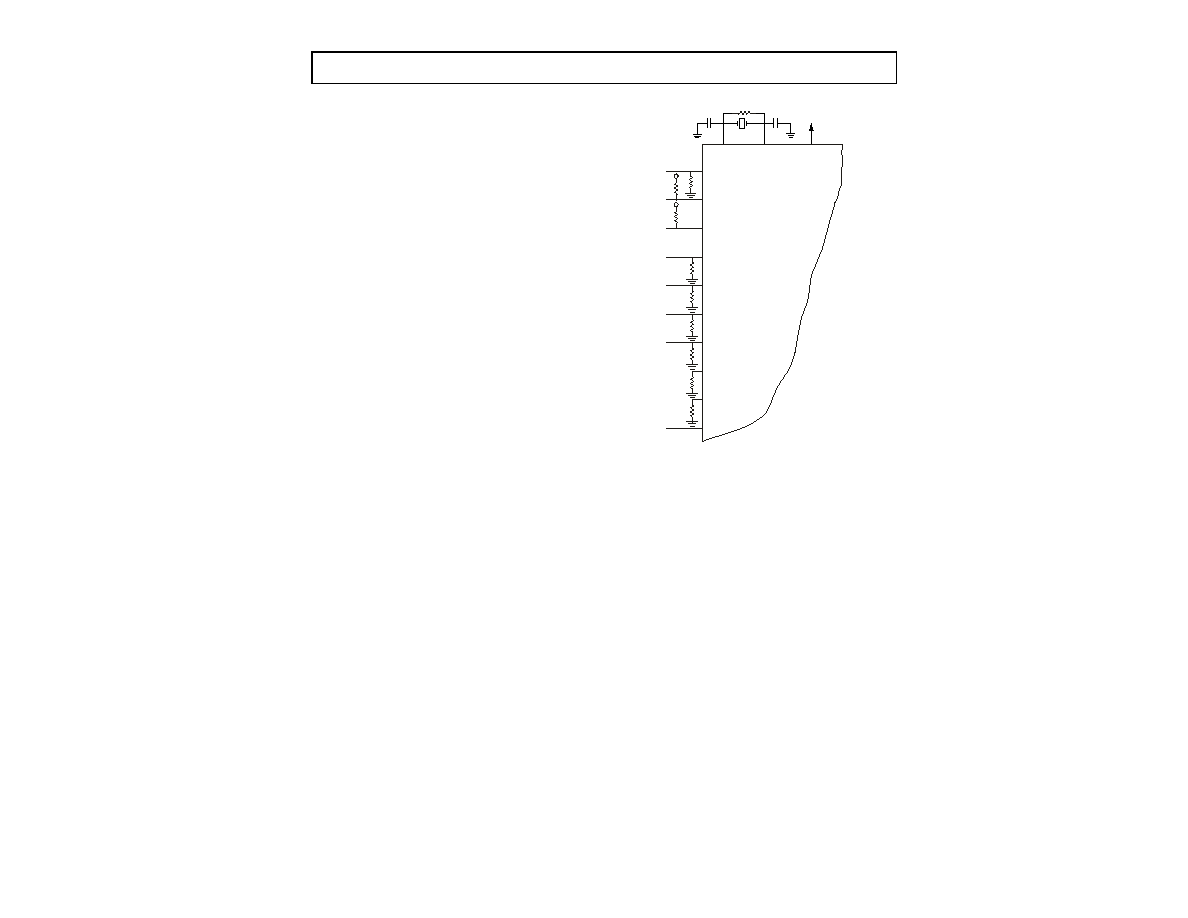
11
REV. 0
ADSP-2191M
To exit Power-Down Core/Peripherals mode, the DSP responds
to an interrupt and (after 500 cycles to restabilize the PLL)
resumes executing instructions with the instruction after the
IDLE.
Clock Signals
The ADSP-2191M can be clocked by a crystal oscillator or a
buffered, shaped clock derived from an external clock oscillator.
If a crystal oscillator is used, the crystal should be connected
across the CLKIN and XTAL pins, with two capacitors and a
1 M
shunt resistor connected as shown in
Figure 3
. Capacitor
values are dependent on crystal type and should be specified by
the crystal manufacturer. A parallel-resonant, fundamental fre-
quency, microprocessor-grade crystal should be used for this
configuration.
If a buffered, shaped clock is used, this external clock connects
to the DSP's CLKIN pin. CLKIN input cannot be halted,
changed, or operated below the specified frequency during
normal operation. When an external clock is used, the XTAL
input must be left unconnected.
The DSP provides a user-programmable 1 to 32 multiplica-
tion of the input clock, including some fractional values, to
support 128 external to internal (DSP core) clock ratios. The
MSEL60, BYPASS, and DF pins decide the PLL multiplication
factor at reset. At runtime, the multiplication factor can be con-
trolled in software. The combination of pullup and pull-down
resistors in
Figure
sets up a core clock ratio of 6:1, which
produces a 150 MHz core clock from the 25 MHz input. For
other clock multiplier settings, see the ADSP-219x/2191 DSP
Hardware Reference.
The peripheral clock is supplied to the CLKOUT pin.
All on-chip peripherals for the ADSP-2191M operate at the rate
set by the peripheral clock. The peripheral clock is either equal
to the core clock rate or one-half the DSP core clock rate. This
selection is controlled by the IOSEL bit in the PLLCTL register.
The maximum core clock is 160 MHz and the maximum periph-
eral clock is 80 MHz--the combination of the input clock and
core/peripheral clock ratios may not exceed these limits.
Reset
The
RESET signal initiates a master reset of the ADSP-2191M.
The
RESET signal must be asserted during the powerup
sequence to assure proper initialization.
RESET during initial
powerup must be held long enough to allow the internal clock to
stabilize.
The powerup sequence is defined as the total time required for
the crystal oscillator circuit to stabilize after a valid V
DD
is applied
to the processor, and for the internal phase-locked loop (PLL) to
lock onto the specific crystal frequency. A minimum of 100 µs
ensures that the PLL has locked, but does not include the crystal
oscillator start-up time. During this powerup sequence the
RESET signal should be held low. On any subsequent resets, the
RESET signal must meet the minimum pulsewidth specifica-
tion, t
WRST
.
The
RESET input contains some hysteresis. If using an RC
circuit to generate your
RESET signal, the circuit should use an
external Schmidt trigger.
The master reset sets all internal stack pointers to the empty stack
condition, masks all interrupts, and resets all registers to their
default values (where applicable). When
RESET is released, if
there is no pending bus request and the chip is configured for
booting, the boot-loading sequence is performed. Program
control jumps to the location of the on-chip boot ROM
(0xFF 0000).
Power Supplies
The ADSP-2191M has separate power supply connections for
the internal (V
DDINT
) and external (V
DDEXT
) power supplies.
The internal supply must meet the 2.5 V requirement. The
external supply must be connected to a 3.3 V supply. All external
supply pins must be connected to the same supply.
Powerup Sequence
Power up together the two supplies V
DDEXT
and V
DDINT
. If
they cannot be powered up together, power up the internal (core)
supply first (powering up the core supply first reduces the risk of
latchup events.
Booting Modes
The ADSP-2191M has five mechanisms (listed in
Table 6
) for
automatically loading internal program memory after reset. Two
No-boot modes are also supported.
Figure 3. External Crystal Connections
CLKIN
CLKOUT
XTAL
ADSP-2191M
MSEL5 (PF5)
MSEL4 (PF4)
MSEL3 (PF3)
MSEL2 (PF2)
MSEL1 (PF1)
MSEL0 (PF0)
RESET
25MHz
MSEL6 (PF6)
DF (PF7)
V
DD
V
DD
BYPASS
RESET
SOURCE
RUNTIME
PF PIN I/O
THE PULL-UP/PULL-DOWN
RESISTORS ON THE MSEL,
DF, AND BYPASS PINS
SELECT THE CORE CLOCK
RATIO.
HERE, THE SELECTION (6:1)
AND 25MHz INPUT CLOCK
PRODUCE A 150MHz CORE
CLOCK.
1M

ADSP-2191M
12
REV. 0
The OPMODE, BMODE1, and BMODE0 pins, sampled
during hardware reset, and three bits in the Reset Configuration
Register implement these modes:
·
Execute from memory external 16 bits--The memory
boot routine located in boot ROM memory space
executes a boot-stream-formatted program located at
address 0x010000 of boot memory space, packing 16-bit
external data into 24-bit internal data. The External Port
Interface is configured for the default clock multiplier
(128) and read waitstates (7).
·
Boot from EPROM--The EPROM boot routine located
in boot ROM memory space fetches a boot-stream-for-
matted program located at physical address 0x00 0000 of
boot memory space, packing 8- or 16-bit external data
into 24-bit internal data. The External Port Interface is
configured for the default clock multiplier (32) and read
waitstates (7).
·
Boot from Host--The (8- or 16-bit) Host downloads a
boot-stream-formatted program to internal or external
memory. The Host's boot routine is located in internal
ROM memory space and uses the top 16 locations of
Page 0 program memory and the top 272 locations of
Page 0 data memory.
The internal boot ROM sets semaphore A (an IO register
within the Host port) and then polls until the semaphore
is reset. Once detected, the internal boot ROM will remap
the interrupt vector table to Page 0 internal memory and
jump to address 0x00 0000 internal memory. From the
point of view of the host interface, an external host has
full control of the DSP's memory map. The Host has the
freedom to directly write internal memory, external
memory, and internal I/O memory space. The DSP core
execution is held off until the Host clears the semaphore
register. This strategy allows the maximum flexibility for
the Host to boot in the program and data code, by leaving
it up to the programmer.
·
Execute from memory external 8 bits (No Boot)--
Execution starts from Page 1 of external memory space,
packing either 8- or 16-bit external data into 24-bit
internal data. The External Port Interface is config-
ured for the default clock multiplier (128) and read
waitstates (7).
·
Boot from UART--The Host downloads
boot-stream-formatted program using an autobaud
handshake sequence. The Host agent selects a baud rate
within the UART's clocking capabilities. After a hardware
reset, the DSP's UART expects a 0xAA character (eight
bits data, one start bit, one stop bit, no parity bit) on the
RXD pin to determine the bit rate; and then replies with
an OK string. Once the host receives this OK it downloads
the boot stream without further handshake.The UART
boot routine is located in internal ROM memory space
and uses the top 16 locations of Page 0 program memory
and the top 272 locations of Page 0 data memory.
·
Boot from SPI, up to 4K bits--The SPI0 port uses the
SPI0SEL1 (reconfigured PF2) output pin to select a
single serial EEPROM device, submits a read command
at address 0x00, and begins clocking consecutive data into
internal or external memory. Use only SPI-compatible
EEPROMs of
4K bit (12-bit address range). The SPI0
boot routine located in internal ROM memory space
executes a boot-stream-formatted program, using the top
16 locations of Page 0 program memory and the top 272
locations of Page 0 data memory. The SPI boot configu-
ration is SPIBAUD0=60 (decimal), CPHA=1, CPOL=1,
8-bit data, and MSB first.
·
Boot from SPI, from >4K bits to 512K bits--The SPI0
port uses the SPI0SEL1 (re-configured PF2) output pin
to select a single serial EEPROM device, submits a read
command at address 0x00, and begins clocking consecu-
tive data into internal or external memory. Use only
SPI-compatible EEPROMs of
4K bit (16-bit address
range). The SPI0 boot routine, located in internal ROM
memory space, executes a boot-stream-formatted
program, using the top 16 locations of Page 0 program
memory and the top 272 locations of Page 0 data memory.
As indicated in
Table 6
, the OPMODE pin has a dual role, acting
as a boot mode select during reset and determining SPORT or
SPI operation at runtime. If the OPMODE pin at reset is the
opposite of what is needed in an application during runtime, the
application needs to set the OPMODE bit appropriately during
runtime prior to using the corresponding peripheral.
Bus Request and Bus Grant
The ADSP-2191M can relinquish control of the data and address
buses to an external device. When the external device requires
access to the bus, it asserts the bus request (
BR) signal. The (BR)
signal is arbitrated with core and peripheral requests. External
Bus requests have the lowest priority. If no other internal request
is pending, the external bus request will be granted. Because of
Table 6. Select Boot Mode (OPMODE, BMODE1, and
BMODE0)
OPMODE
BMO
D
E1
BMO
D
E0
Function
0
0
0
Execute from external memory 16 bits
(No Boot)
0
0
1
Boot from EPROM
0
1
0
Boot from Host
0
1
1
Reserved
1
0
0
Execute from external memory 8 bits
(No Boot)
1
0
1
Boot from UART
1
1
0
Boot from SPI, up to 4K bits
1
1
1
Boot from SPI, >4K bits up to
512K bits

13
REV. 0
ADSP-2191M
synchronizer and arbitration delays, bus grants will be provided
with a minimum of three peripheral clock delays. ADSP-2191M
DSPs will respond to the bus grant by:
·
Three-stating the data and address buses and the
MS30,
BMS, IOMS, RD, and WR output drivers.
·
Asserting the bus grant (
BG) signal.
The ADSP-2191M will halt program execution if the bus is
granted to an external device and an instruction fetch or data
read/write request is made to external general-purpose or periph-
eral memory spaces. If an instruction requires two external
memory read accesses, bus requests will not be granted between
the two accesses. If an instruction requires an external memory
read and an external memory write access, the bus may be
granted between the two accesses. The external memory
interface can be configured so that the core will have exclusive
use of the interface. DMA and Bus Requests will be granted.
When the external device releases
BR, the DSP releases BG and
continues program execution from the point at which it stopped.
The bus request feature operates at all times, even while the DSP
is booting and
RESET is active.
The ADSP-2191M asserts the
BGH pin when it is ready to start
another external port access, but is held off because the bus was
previously granted. This mechanism can be extended to define
more complex arbitration protocols for implementing more
elaborate multimaster systems.
Instruction Set Description
The ADSP-2191M assembly language instruction set has an
algebraic syntax that was designed for ease of coding and read-
ability. The assembly language, which takes full advantage of the
processor's unique architecture, offers the following benefits:
·
ADSP-219x assembly language syntax is a superset of and
source-code-compatible (except for two data registers
and DAG base address registers) with ADSP-218x family
syntax. It may be necessary to restructure ADSP-218x
programs to accommodate the ADSP-2191M's unified
memory space and to conform to its interrupt vector map.
·
The algebraic syntax eliminates the need to remember
cryptic assembler mnemonics. For example, a typical
arithmetic add instruction, such as AR = AX0 + AY0,
resembles a simple equation.
·
Every instruction, but two, assembles into a single, 24-bit
word that can execute in a single instruction cycle. The
exceptions are two dual word instructions. One writes 16-
or 24-bit immediate data to memory, and the other is an
absolute jump/call with the 24-bit address specified in the
instruction.
·
Multifunction instructions allow parallel execution of an
arithmetic, MAC, or shift instruction with up to two
fetches or one write to processor memory space during a
single instruction cycle.
·
Program flow instructions support a wider variety of con-
ditional and unconditional jumps/calls and a larger set of
conditions on which to base execution of conditional
instructions.
Development Tools
The ADSP-2191M is supported with a complete set of software
and hardware development tools, including Analog Devices
emulators and VisualDSP++® development environment. The
same emulator hardware that supports other ADSP-219x DSPs,
also fully emulates the ADSP-2191M.
The VisualDSP++ project management environment lets pro-
grammers develop and debug an application. This environment
includes an easy-to-use assembler that is based on an algebraic
syntax; an archiver (librarian/library builder), a linker, a loader,
a cycle-accurate instruction-level simulator, a C/C++ compiler,
and a C/C++ run-time library that includes DSP and mathemat-
ical functions. Two key points for these tools are:
·
Compiled ADSP-219x C/C++ code efficiency--the
compiler has been developed for efficient translation of
C/C++ code to ADSP-219x assembly. The DSP has
architectural features that improve the efficiency of
compiled C/C++ code.
·
ADSP-218x family code compatibility--The assembler
has legacy features to ease the conversion of existing
ADSP-218x applications to the ADSP-219x.
Debugging both C/C++ and assembly programs with the Visu-
alDSP++ debugger, programmers can:
·
View mixed C/C++ and assembly code (interleaved
source and object information)
·
Insert break points
·
Set conditional breakpoints on registers, memory, and
stacks
·
Trace instruction execution
·
Perform linear or statistical profiling of program
execution
·
Fill, dump, and graphically plot the contents of memory
·
Source level debugging
·
Create custom debugger windows
The VisualDSP++ IDE lets programmers define and manage
DSP software development. Its dialog boxes and property pages
let programmers configure and manage all of the ADSP-219x
development tools, including the syntax highlighting in the Visu-
alDSP++ editor. This capability permits:
·
Control how the development tools process inputs and
generate outputs.
·
Maintain a one-to-one correspondence with the tool's
command line switches.
Analog Devices DSP emulators use the IEEE 1149.1 JTAG test
access port of the ADSP-2191M processor to monitor and
control the target board processor during emulation. The
emulator provides full-speed emulation, allowing inspection and
modification of memory, registers, and processor stacks. Nonin-
trusive in-circuit emulation is assured by the use of the processor's
JTAG interface--the emulator does not affect target system
loading or timing.
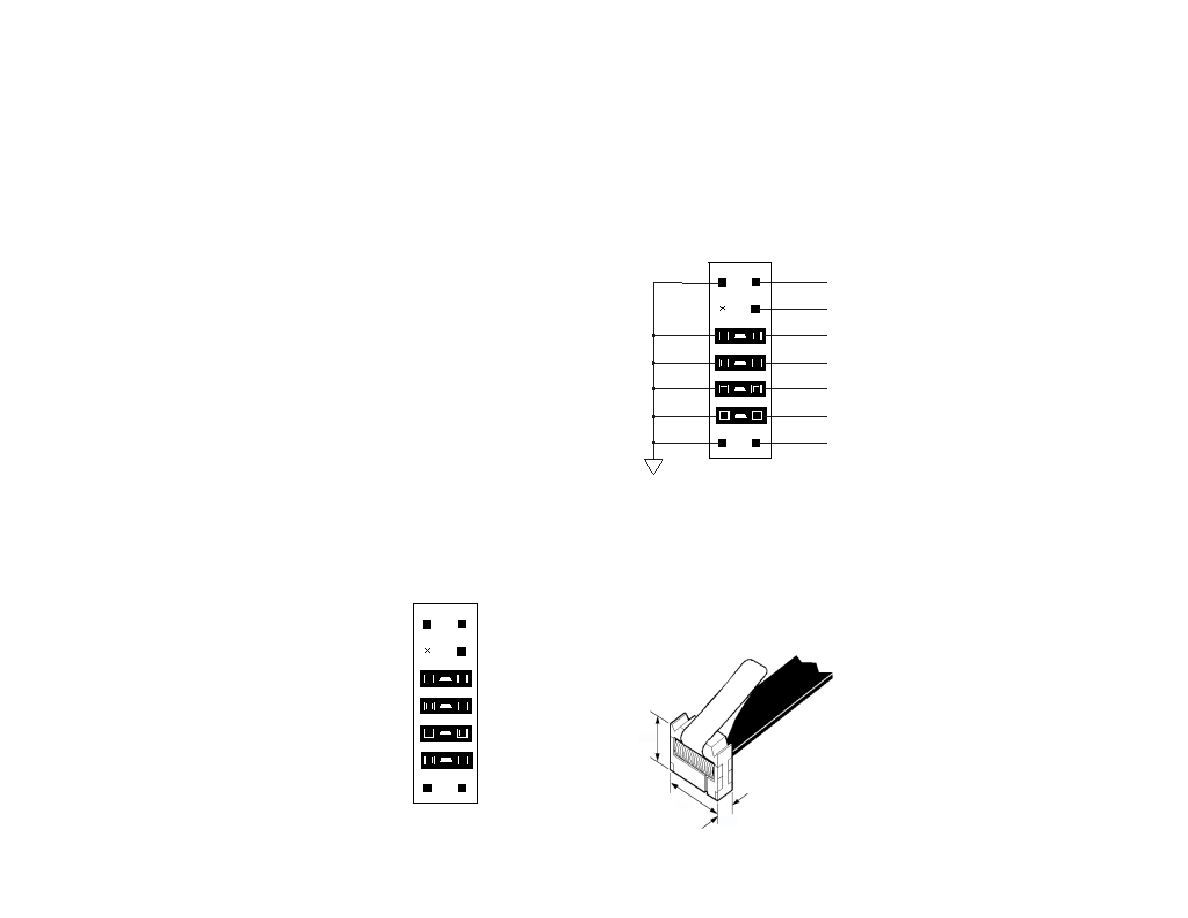
ADSP-2191M
14
REV. 0
In addition to the software and hardware development tools
available from Analog Devices, third parties provide a wide range
of tools supporting the ADSP-219x processor family. Hardware
tools include ADSP-219x PC plug-in cards. Third party software
tools include DSP libraries, real-time operating systems, and
block diagram design tools.
Designing an Emulator-Compatible DSP Board
(Target)
The White Mountain DSP (Product Line of Analog Devices,
Inc.) family of emulators are tools that every DSP developer
needs to test and debug hardware and software systems. Analog
Devices has supplied an IEEE 1149.1 JTAG Test Access Port
(TAP) on each JTAG DSP. The emulator uses the TAP to access
the internal features of the DSP, allowing the developer to load
code, set breakpoints, observe variables, observe memory, and
examine registers. The DSP must be halted to send data and
commands, but once an operation has been completed by the
emulator, the DSP system is set running at full speed with no
impact on system timing.
To use these emulators, the target's design must include the
interface between an Analog Devices JTAG DSP and the
emulation header on a custom DSP target board.
Target Board Header
The emulator interface to an Analog Devices JTAG DSP is a
14-pin header, as shown in
Figure 4
. The customer must supply
this header on the target board in order to communicate with the
emulator. The interface consists of a standard dual row 0.025"
square post header, set on 0.1"
0.1" spacing, with a minimum
post length of 0.235". Pin 3 is the key position used to prevent
the pod from being inserted backwards. This pin must be clipped
on the target board.
Also, the clearance (length, width, and height) around the header
must be considered. Leave a clearance of at least 0.15" and 0.10"
around the length and width of the header, and reserve a height
clearance to attach and detach the pod connector.
As can be seen in
Figure 4
, there are two sets of signals on the
header. There are the standard JTAG signals TMS, TCK, TDI,
TDO,
TRST, and EMU used for emulation purposes (via an
emulator). There are also secondary JTAG signals BTMS,
BTCK, BTDI, and
BTRST that are optionally used for
board-level (boundary scan) testing.
When the emulator is not connected to this header, place jumpers
across BTMS, BTCK,
BTRST, and BTDI as shown in
Figure 5
.
This holds the JTAG signals in the correct state to allow the DSP
to run free. Remove all the jumpers when connecting the
emulator to the JTAG header.
JTAG Emulator Pod Connector
Figure 6
details the dimensions of the JTAG pod connector at the
14-pin target end.
Figure 7
displays the keep-out area for a target
board header. The keep-out area allows the pod connector to
properly seat onto the target board header. This board area
should contain no components (chips, resistors, capacitors, etc.).
The dimensions are referenced to the center of the 0.25" square
post pin.
Figure 4. JTAG Target Board Connector for JTAG
Equipped Analog Devices DSP (Jumpers in
Place)
TOP VIEW
13
14
11
12
9
10
9
7
8
5
6
3
4
1
2
EMU
GND
TMS
TCK
TRST
TDI
TDO
GND
KEY (NO PIN)
BTMS
BTCK
BTRST
BTDI
GND
Figure 5. JTAG Target Board Connector with No Local
Boundary Scan
Figure 6. JTAG Pod Connector Dimensions
TOP VIEW
13
14
11
12
9
10
9
7
8
5
6
3
4
1
2
EMU
GND
TMS
TCK
TRST
TDI
TDO
GND
KEY (NO PIN)
BTMS
BTCK
BTRST
BTDI
GND
0.64"
0.88"
0.24"
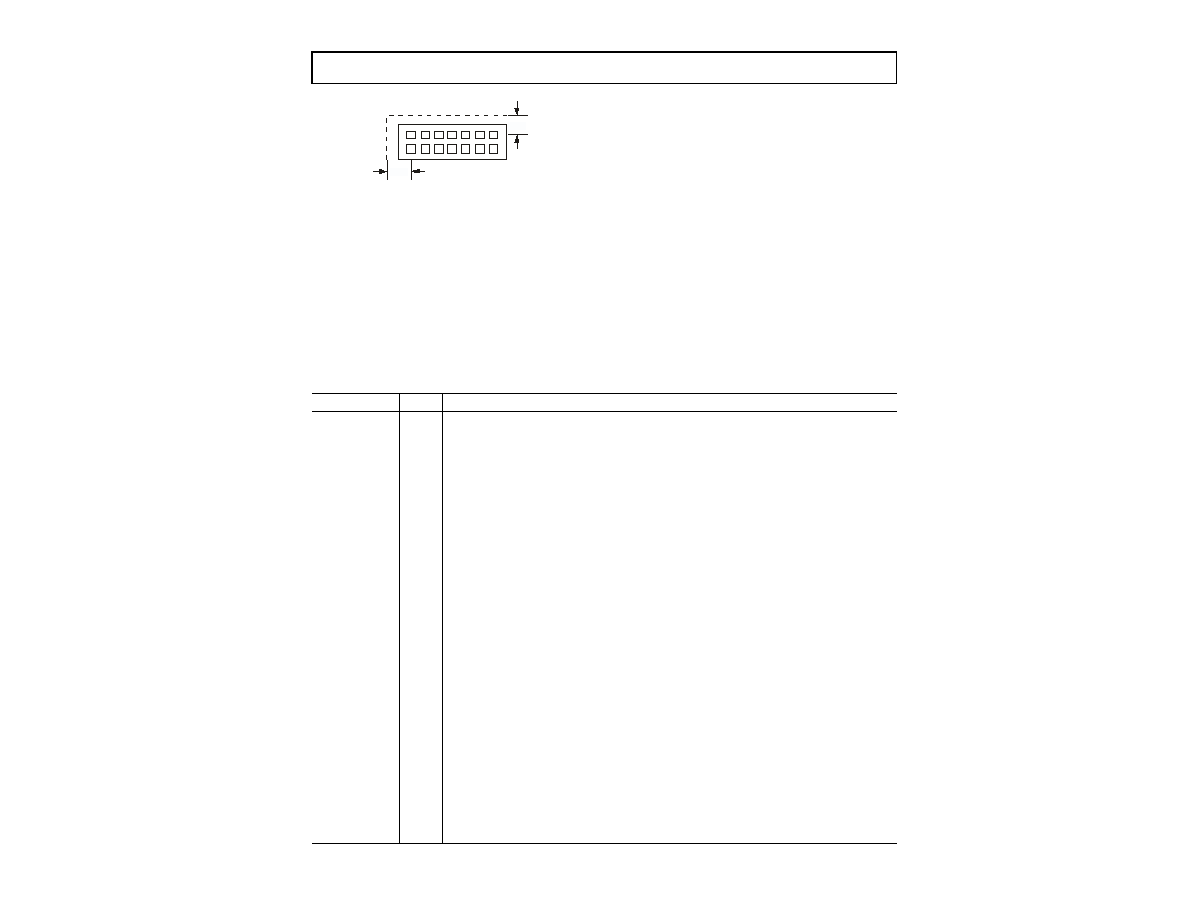
15
REV. 0
ADSP-2191M
Design-for-Emulation Circuit Information
For details on target board design issues including: single
processor connections, multiprocessor scan chains, signal buff-
ering, signal termination, and emulator pod logic, see the EE-68:
Analog Devices JTAG Emulation Technical Reference on the Analog
Devices website (www.analog.com)--use site search on
"EE-68." This document is updated regularly to keep pace with
improvements to emulator support.
Additional Information
This data sheet provides a general overview of the ADSP-2191M
architecture and functionality. For detailed information on the
core architecture of the ADSP-219x family, refer to the
ADSP-219x/2191 DSP Hardware Reference. For details on the
instruction set, refer to the ADSP-219x Instruction Set Reference.
PIN FUNCTION DESCRIPTIONS
ADSP-2191M pin definitions are listed in
Table 7
. All
ADSP-2191M inputs are asynchronous and can be asserted
asynchronously to CLKIN (or to TCK for
TRST).
Tie or pull unused inputs to V
DDEXT
or GND, except for
ADDR210, DATA150, PF7-0, and inputs that have internal
pull-up or pull-down resistors (
TRST, BMODE0, BMODE1,
OPMODE, BYPASS, TCK, TMS, TDI, and
RESET)--these
pins can be left floating. These pins have a logic-level hold circuit
that prevents input from floating internally.
The following symbols appear in the Type column of
Table
: G
= Ground, I = Input, O = Output, P = Power Supply, and T =
Three-State.
Figure 7. JTAG Pod Connector Keep-Out Area
0.10"
0.15"
Table 7. Pin Function Descriptions
Pin Type
Function
A210
O/T
External Port Address Bus
D70
I/O/T
External Port Data Bus, least significant 8 bits
D15
/PF15
/SPI1SEL7
I/O/T
I/O
I
Data 15 (if 16-bit external bus)/Programmable Flags 15 (if 8-bit external bus)/SPI1 Slave
Select output 7 (if 8-bit external bus, when SPI1 enabled)
D14
/PF14
/SPI0SEL7
I/O/T
I/O
I
Data 14 (if 16-bit external bus)/Programmable Flags 14 (if 8-bit external bus)/SPI0 Slave
Select output 7 (if 8-bit external bus, when SPI0 enabled)
D13
/PF12
/SPI1SEL6
I/O/T
I/O
I
Data 13 (if 16-bit external bus)/Programmable Flags 13 (if 8-bit external bus)/SPI1 Slave
Select output 6 (if 8-bit external bus, when SPI1 enabled)
D12
/PF12
/SPI0SEL6
I/O/T
I/O
I
Data 12 (if 16-bit external bus)/Programmable Flags 12 (if 8-bit external bus)/SPI0 Slave
Select output 6 (if 8-bit external bus, when SPI0 enabled)
D11
/PF11
/SPI1SEL5
I/O/T
I/O
I
Data 11 (if 16-bit external bus)/Programmable Flags 11 (if 8-bit external bus)/SPI1 Slave
Select output 5 (if 8-bit external bus, when SPI1 enabled)
D10
/PF10
/SPI0SEL5
I/O/T
I/O
I
Data 10 (if 16-bit external bus)/Programmable Flags 10 (if 8-bit external bus)/SPI0 Slave
Select output 5 (if 8-bit external bus, when SPI0 enabled)
D9
/PF9
/SPI1SEL4
I/O/T
I/O
I
Data 9 (if 16-bit external bus)/Programmable Flags 9 (if 8-bit external bus)/SPI1 Slave Select
output 4 (if 8-bit external bus, when SPI1 enabled)
D8
/PF8
/SPI0SEL4
I/O/T
I/O
I
Data 8 (if 16-bit external bus)/Programmable Flags 8 (if 8-bit external bus)/SPI0 Slave Select
output 4 (if 8-bit external bus, when SPI0 enabled)
PF7
/SPI1SEL3
/DF
I/O/T
I
I
Programmable Flags 7/SPI1 Slave Select output 3 (when SPI0 enabled)/Divisor Frequency
(divisor select for PLL input during boot)
PF6
/SPI0SEL3
/MSEL6
I/O/T
I
I
Programmable Flags 6/SPI0 Slave Select output 3 (when SPI0 enabled)/Multiplier Select 6
(during boot)

ADSP-2191M
16
REV. 0
PF5
/SPI1SEL2
/MSEL5
I/O/T
I
I
Programmable Flags 5/SPI1 Slave Select output 2 (when SPI0 enabled)/Multiplier Select 5
(during boot)
PF4
/SPI0SEL2
/MSEL4
I/O/T
I
I
Programmable Flags 4/SPI0 Slave Select output 2 (when SPI0 enabled)/Multiplier Select 4
(during boot)
PF3
/SPI1SEL1
/MSEL3
I/O/T
I
I
Programmable Flags 3/SPI1 Slave Select output 1 (when SPI0 enabled)/Multiplier Select 3
(during boot)
PF2
/SPI0SEL1
/MSEL2
I/O/T
I
I
Programmable Flags 2/SPI0 Slave Select output 1 (when SPI0 enabled)/Multiplier Select 2
(during boot)
PF1
/SPISS1
/MSEL1
I/O/T
I
I
Programmable Flags 1/SPI1 Slave Select input (when SPI1 enabled)/Multiplier Select 1
(during boot)
PF0
/SPISS0
/MSEL0
I/O/T
I
I
Programmable Flags 0/SPI0 Slave Select input (when SPI0 enabled)/Multiplier Select 0
(during boot)
RD
O/T
External Port Read Strobe
WR
O/T
External Port Write Strobe
ACK
I
External Port Access Ready Acknowledge
BMS
O/T
External Port Boot Space Select
IOMS
O/T
External Port IO Space Select
MS30
O/T
External Port Memory Space Selects
BR
I
External Port Bus Request
BG
O
External Port Bus Grant
BGH
O
External Port Bus Grant Hang
HAD150
I/O/T
Host Port Multiplexed Address and Data Bus
HA16
I
Host Port MSB of Address Bus
HACK_P
I
Host Port ACK Polarity
HRD
I
Host Port Read Strobe
HWR
I
Host Port Write Strobe
HACK
O
Host Port Access Ready Acknowledge
HALE
I
Host Port Address Latch Strobe or Address Cycle Control
HCMS
I
Host Port Internal MemoryInternal I/O MemoryBoot Memory Select
HCIOMS
I
Host Port Internal I/O Memory Select
CLKIN
I
Clock Input/Oscillator input
XTAL
O
Oscillator output
BMODE10
I
Boot Mode 10. The BMODE1 and BMODE0 pins have 85 k
internal pull-up resistors.
OPMODE
I
Operating Mode. The OPMODE pin has a 85 k
internal pull-up resistor.
CLKOUT
O
Clock Output
BYPASS
I
Phase-Lock-Loop (PLL) Bypass mode. The BYPASS pin has a 85 k
internal pull-up resistor.
RCLK10
I/O/T
SPORT10 Receive Clock
RCLK2/SCK1
I/O/T
SPORT2 Receive Clock/SPI1 Serial Clock
RFS10
I/O/T
SPORT10 Receive Frame Sync
RFS2/MOSI1
I/O/T
SPORT2 Receive Frame Sync/SPI1 Master-Output, Slave-Input data
TCLK10
I/O/T
SPORT10 Transmit Clock
TCLK2/SCK0
I/O/T
SPORT2 Transmit Clock/SPI0 Serial Clock
TFS10
I/O/T
SPORT10 Transmit Frame Sync
TFS2/MOSI0
I/O/T
SPORT2 Transmit Frame Sync/SPI0 Master-Output, Slave-Input data
DR10
I/T
SPORT10 Serial Data Receive
DR2/MISO1
I/O/T
SPORT2 Serial Data Receive/SPI1 Master-Input, Slave-Output data
DT10
O/T
SPORT10 Serial Data Transmit
DT2/MISO0
I/O/T
SPORT2 Serial Data Transmit/SPI0 Master-Input, Slave-Output data
TMR20
I/O/T
Timer output or capture
Table 7. Pin Function Descriptions (continued)
Pin Type
Function

17
REV. 0
ADSP-2191M
RXD
I
UART Serial Receive Data
TXD
O
UART Serial Transmit Data
RESET
I
Processor Reset. Resets the ADSP-2191M to a known state and begins execution at the
program memory location specified by the hardware reset vector address. The
RESET input
must be asserted (low) at powerup. The RESET pin has an 85 k
internal pull-up resistor.
TCK
I
Test Clock (JTAG). Provides a clock for JTAG boundary scan. The TCK pin has an 85 k
internal pull-up resistor.
TMS
I
Test Mode Select (JTAG). Used to control the test state machine. The TMS pin has an 85 k
internal pull-up resistor.
TDI
I
Test Data Input (JTAG). Provides serial data for the boundary scan logic. The TDI pin has a
85 k
internal pull-up resistor.
TDO
O
Test Data Output (JTAG). Serial scan output of the boundary scan path.
TRST
I
Test Reset (JTAG). Resets the test state machine.
TRST must be asserted (pulsed low) after
powerup or held low for proper operation of the ADSP-2191M. The
TRST pin has a 65 k
internal pull-down resistor.
EMU
O
Emulation Status (JTAG). Must be connected to the ADSP-2191M emulator target board
connector only.
V
DDINT
P
Core Power Supply. Nominally 2.5 V dc and supplies the DSP's core processor. (four pins)
V
DDEXT
P
I/O Power Supply. Nominally 3.3 V dc. (nine pins)
GND
G
Power Supply Return. (twelve pins)
NC
Do Not Connect. Reserved pins that must be left open and unconnected.
Table 7. Pin Function Descriptions (continued)
Pin Type
Function

ADSP-2191M
18
REV. 0
SPECIFICATIONS
RECOMMENDED OPERATING CONDITIONS
Parameter
1
1
Specifications subject to change without notice.
Test Conditions
K Grade (Commercial)
Min Max
B Grade (Industrial)
Min Max
Unit
V
DDINT
Internal (Core) Supply
Voltage
2.37
2.63
2.37
2.63
V
V
DDEXT
External (I/O) Supply
Voltage
2.97
3.6
2.97
3.6
V
V
IH
High Level Input Voltage
@ V
DDINT
= max,
V
DDEXT
= max
2.0
V
DDEXT
+ 0.3 2.0
V
DDEXT
+ 0.3 V
V
IL
Low Level Input Voltage
@ V
DDINT
= min,
V
DDEXT
= min
0.3
0.8
0.3
0.8
V
T
AMB
Ambient Operating
Temperature
0
70
40
+ 85
ºC
ELECTRICAL CHARACTERISTICS
Parameter
1
1
Specifications subject to change without notice.
Test Conditions
K and B Grades
Min Typ
Max
Unit
V
OH
High Level Output Voltage
2
2
Applies to output and bidirectional pins: DATA150, ADDR210, HAD150,
MS30, IOMS, RD, WR, CLKOUT, HACK, PF70, TMR20, BGH,
BG, DT0, DT1, DT2/MISO0, TCLK0, TCLK1, TCLK2/SCK0, RCLK0, RCLK1, RCLK2/SCK1, TFS0, TFS1, TFS2/MOSI0, RFS0, RFS1,
RFS2/MOSI1,
BMS, TDO, TXD, EMU, DR2/MISO1.
@ V
DDEXT
= min,
I
OH
= 0.5 mA
2.4
V
V
OL
Low Level Output Voltage
2
@ V
DDEXT
= min,
I
OL
= 2.0 mA
0.4
V
I
IH
High Level Input Current
3, 4
3
Applies to input pins: ACK,
BR, HCMS, HCIOMS, HA16, HALE, HRD, HWR, CLKIN, DR0, DR1, RXD, HACK_P.
4
Applies to input pins with internal pull-ups: BMODE0, BMODE1, OPMODE, BYPASS, TCK, TMS, TDI,
RESET.
@ V
DDEXT
= max,
V
IN
= V
DD
max
10
µA
I
IL
Low Level Input Current
3, 5
5
Applies to input pin with internal pull-down: TRST.
@ V
DDEXT
= max,
V
IN
= 0 V
10
µA
I
IHP
High Level Input Current
5
@ V
DDEXT
= max,
V
IN
= V
DD
max
30
100
µA
I
ILP
Low Level Input Current
4
@ V
DDEXT
= max,
V
IN
= 0 V
20
70
µA
I
OZH
Three-State Leakage Current
6
6
Applies to three-statable pins: DATA150, ADDR210,
MS30, RD, WR, PF70, BMS, IOMS, TFSx, RFSx, TDO, EMU, TCLKx, RCLKx, DTx,
HAD150, TMR20.
@ V
DDEXT
= max,
V
IN
= V
DD
max
10
µA
I
OZL
Three-State Leakage Current
6
@ V
DDEXT
= max,
V
IN
= 0 V
10
µA
C
IN
Input Capacitance
7, 8
7
Applies to all signal pins.
8
Guaranteed, but not tested.
f
IN
= 1 MHz,
T
CASE
= 25°C,
V
IN
= 2.5 V
8
pF

19
REV. 0
ADSP-2191M
ABSOLUTE MAXIMUM RATINGS
ESD SENSITIVITY
Power Dissipation
Using the operation-versus-current information in
Table 8
, designers can estimate the ADSP-2191M's internal power supply
(V
DDINT
) input current for a specific application, according to the formula for I
DDINT
calculation beneath
Table 8
. For calculation
of external supply current and total supply current,
see Power Dissipation on page 41.
V
DDINT
Internal (Core) Supply Voltage
1,2
. . 0.3 V to 3.0 V
1
Specifications subject to change without notice.
2
Stresses greater than those listed above may cause permanent damage to the device.
These are stress ratings only; functional operation of the device at these or any
other conditions greater than those indicated in the operational sections of this
specification is not implied. Exposure to absolute maximum rating conditions for
extended periods may affect device reliability.
V
DDEXT
External (I/O) Supply Voltage . . . . 0.3 V to 4.6 V
V
IL
V
IH
Input Voltage . . . . . . . . 0.5 V to V
DDEXT
+ 0.5 V
V
OL
V
OH
Output Voltage Swing . 0.5 V to V
DDEXT
+ 0.5 V
T
STORE
Storage Temperature Range . . . . . . 65ºC to 150ºC
T
LEAD
Lead Temperature of ST-144 (5 seconds) . . . . 185ºC
CAUTION
ESD (electrostatic discharge) sensitive device. Electrostatic charges as high as 4000V
readily accumulate on the human body and test equipment and can discharge without
detection. Although the ADSP-2191M features proprietary ESD protection circuitry,
permanent damage may occur on devices subjected to high-energy electrostatic
discharges. Therefore, proper ESD precautions are recommended to avoid perfor-
mance degradation or loss of functionality.
Table 8. Operation Types Versus Input Current
K-Grade
I
DDINT
(mA) CCLK = 160 MHz
B-Grade
I
DDINT
(mA)
1
CCLK = 140 MHz
Core
Peripheral
Core
Peripheral
Activity
Typ
1
1
Test conditions: VDDINT= 2.50 V; HCLK (peripheral clock) frequency = CCLK/2 (core clock/2) frequency; TAMB = 25ºC.
Max
2
2
Test conditions: VDDINT= 2.65 V; HCLK (peripheral clock) frequency = CCLK/2 (core clock/2) frequency; TAMB = 25ºC.
Typ
1
Max
2
Typ
1
Max
2
Typ
1
Max
2
Power Down
3
3
PLL, Core, peripheral clocks, and CLKIN are disabled.
100µA
600µA
0
50µA
100µA
500µA
0
50µA
Idle 1
4
4
PLL is enabled and Core and peripheral clocks are disabled.
1
2
5
8
1
2
4
7
Idle 2
5
5
Core CLK is disabled and peripheral clock is enabled.
1
2
60
70
1
2
55
62
Typical
6
6
All instructions execute from internal memory. 50% of the instructions are repeat MACs with dual operand addressing, with changing data fetched using
a linear address sequence. 50% of the instructions are type 3 instructions.
184
210
60
70
165
185
55
62
Peak
7
7
All instructions execute from internal memory. 100% of the instructions are MACs with dual operand addressing, with changing data fetched using a linear
address sequence.
215
240
60
70
195
210
55
62
I
DDINT
%Typical
I
DDINT-TYPICAL
×
(
)
=
%Idle
I
DDINT-IDLE
×
(
)
%Power Down
I
DDINT-PWRDWN
×
(
)
+
+

ADSP-2191M
20
REV. 0
TIMING SPECIFICATIONS
This section contains timing information for the DSP's external signals. Use the exact information given. Do not attempt to derive
parameters from the addition or subtraction of other information. While addition or subtraction would yield meaningful results for an
individual device, the values given in this datasheet reflect statistical variations and worst cases. Consequently, parameters cannot be
added meaningfully to derive longer times.
Switching characteristics specify how the processor changes its signals. No control is possible over this timing; circuitry external to the
processor must be designed for compatibility with these signal characteristics. Switching characteristics indicate what the processor
will do in a given circumstance. Switching characteristics can also be used to ensure that any timing requirement of a device connected
to the processor (such as memory) is satisfied.
Timing requirements apply to signals that are controlled by circuitry external to the processor, such as the data input for a read
operation.Timing requirements guarantee that the processor operates correctly with other devices.
Clock In and Clock Out Cycle Timing
Table 9
and
Figure 8
describe clock and reset operations. Combinations of CLKIN and clock multipliers must not select core/periph-
eral clocks in excess of 160/80 MHz for commercial grade and 140/70 MHz for industrial grade, when the peripheral clock rate is
one-half the core clock rate. If the peripheral clock rate is equal to the core clock rate, the maximum peripheral clock rate is 80 MHz
for both commercial and industrial grade parts. The peripheral clock is supplied to the CLKOUT pins.
When changing from bypass mode to PLL mode, allow 512 HCLK cycles for the PLL to stabilize.
Table 9. Clock In and Clock Out Cycle Timing
Parameter
Min
Max
Unit
Switching Characteristics
t
CKOD
CLKOUT Delay from CLKIN
0
5.8
ns
t
CKO
CLKOUT Period
1
1
CLKOUT jitter can be as great as 8 ns when CLKOUT frequency is less than 20 MHz. For frequencies greater than 20 MHz, jitter is less than 1 ns.
12.5
ns
Timing Requirements
t
CK
CLKIN Period
2,
3
2
In clock multiplier mode and MSEL60 set for 1:1 (or CLKIN = CCLK), t
CK
= tCCLK.
3
In bypass mode, t
CK
= t
CCLK
.
10
200
ns
t
CKL
CLKIN Low Pulse
4.5
ns
t
CKH
CLKIN High Pulse
4.5
ns
t
WRST
RESET Asserted Pulsewidth Low
200t
CLKOUT
ns
t
MSS
MSELx/BYPASS Stable Before
RESET Deasserted Setup
40
µs
t
MSH
MSELx/BYPASS Stable After
RESET Deasserted Hold
1000
ns
t
MSD
MSELx/BYPASS Stable After
RESET Asserted
200
ns
t
PFD
Flag Output Disable Time After
RESET Asserted
10
ns
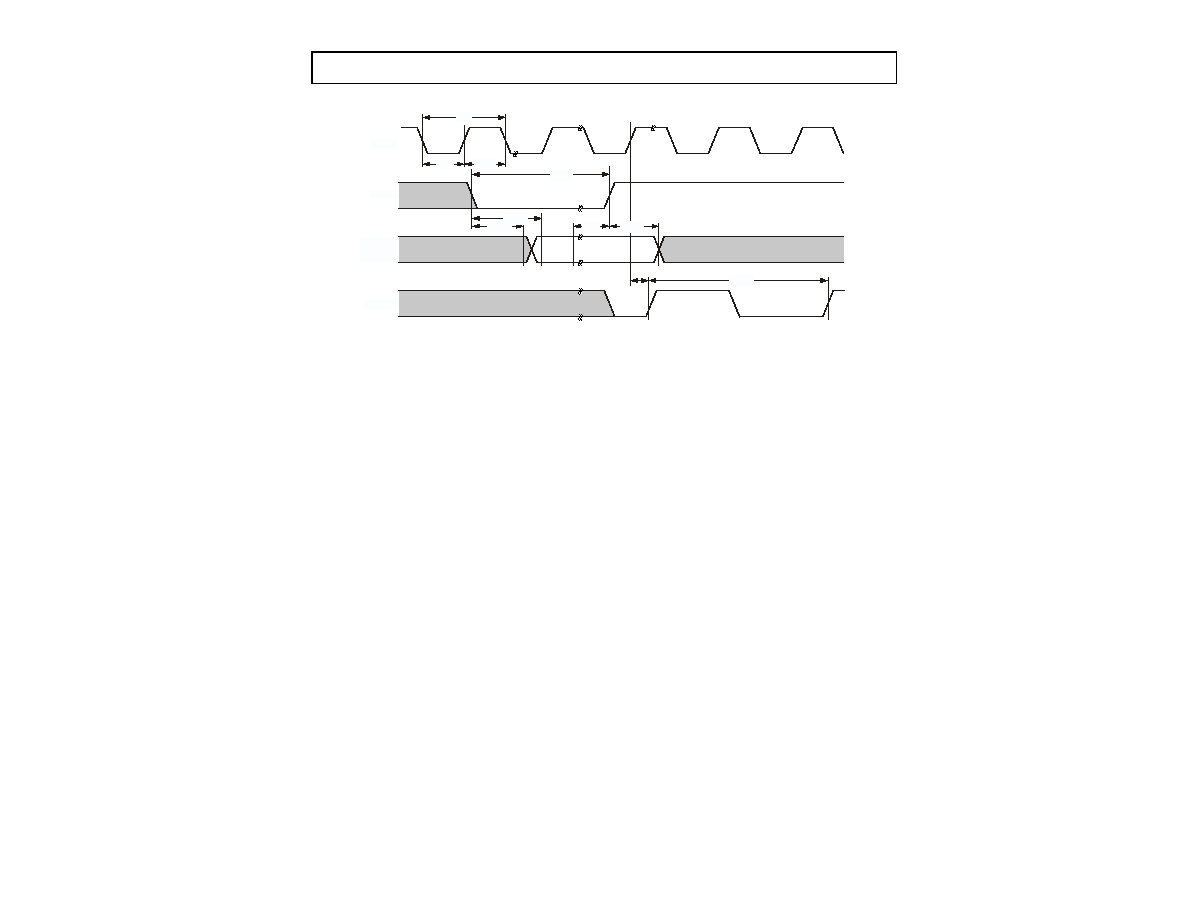
21
REV. 0
ADSP-2191M
Figure 8. Clock In and Clock Out Cycle Timing
t
C K O D
CL KOU T
MS EL 60
B YPAS S
DF
RESET
CLKI N
t
W R S T
t
C K H
t
C K
t
C K L
t
M S H
t
C K O
t
P F D
t
M S D
t
M S S

ADSP-2191M
22
REV. 0
Programmable Flags Cycle Timing
Table 10
and
Figure 9
describe Programmable Flag operations.
Timer PWM_OUT Cycle Timing
Table 11
and
Figure 10
describe timer expired operations. The input signal is asynchronous in "width capture mode" and has an
absolute maximum input frequency of 40 MHz.
Table 10. Programmable Flags Cycle Timing
Parameter
Min
Max
Unit
Switching Characteristics
t
DFO
Flag Output Delay with Respect to CLKOUT
7
ns
t
HFO
Flag Output Hold After CLKOUT High
6
ns
Timing Requirement
t
HFI
Flag Input Hold is asynchronous
3
ns
Figure 9. Programmable Flags Cycle Timing
Table 11. Timer PWM_OUT Cycle Timing
Parameter
Min
Max
Unit
Switching Characteristic
t
HTO
Timer Pulsewidth Output
1
1
The minimum time for t
HTO
is one cycle, and the maximum time for t
HTO
equals (2
32
1) cycles.
12.5
(2
32
1) cycles
ns
Figure 10. Timer PWM_OUT Cycle Timing
FLAG INPUT
PF
(INPUT)
t
HFI
PF
(OUTPUT)
CLKOUT
FLAG OUTPUT
t
DFO
t
HFO
HCLK
P W M _OUT
t
H T O

23
REV. 0
ADSP-2191M
External Port Write Cycle Timing
Table 12
and
Figure 11
describe external port write operations.
The external port lets systems extend read/write accesses in three ways: waitstates, ACK input, and combined waitstates and ACK.
To add waits with ACK, the DSP must see ACK low at the rising edge of EMI clock. ACK low causes the DSP to wait, and the DSP
requires two EMI clock cycles after ACK goes high to finish the access. For more information, see the External Port chapter in the
ADSP-219x/2191 DSP Hardware Reference.
Table 12. External Port Write Cycle Timing
Parameter
1, 2
1
t
HCLK
is the peripheral clock period.
2
These are timing parameters that are based on worst-case operating conditions.
Min
Max
Unit
Switching Characteristics
t
CSWS
Chip Select Asserted to
WR Asserted Delay
0.5t
HCLK
4
ns
t
AWS
Address Valid to
WR Setup and Delay
0.5t
HCLK
3
ns
t
WSCS
WR Deasserted to Chip Select Deasserted
0.5t
HCLK
4
ns
t
WSA
WR Deasserted to Address Invalid
0.5t
HCLK
3
ns
t
WW
WR Strobe Pulsewidth
t
HCLK
2 + W
3
3
W = (number of waitstates specified in wait register) t
HCLK.
ns
t
CDA
WR to Data Enable Access Delay
0
ns
t
CDD
WR to Data Disable Access Delay
0.5t
HCLK
3
0.5t
HCLK
+ 4
ns
t
DSW
Data Valid to
WR Deasserted Setup
t
HCLK
+ 1 +W
3
t
HCLK
+ 7 + W
3
ns
t
DHW
WR Deasserted to Data Invalid Hold Time; E_WHC
4
4
Write hold cyclememory select control registers (MS
CTL).
3.4
ns
t
DHW
WR Deasserted to Data Invalid Hold Time; E_WHC
4
t
HCLK
+ 3.4
ns
t
WWR
WR Deasserted to WR, RD Asserted
t
HCLK
Timing Requirements
t
AKW
ACK Strobe Pulsewidth
12.5
ns
t
DWSAK
ACK Delay from
WR Low
0
ns
Figure 11. External Port Write Cycle Timing
D 1 5 0
t
A W S
t
W W
t
A K W
t
D S W
t
D H W
t
C D D
A C K
W R
A 2 1 0
M S 3 0
IO M S
B M S
t
C S W S
t
W S A
t
W S C S
t
C D A
t
D W S A K
t
W W R
R D

ADSP-2191M
24
REV. 0
External Port Read Cycle Timing
Table 13
and
Figure 12
describe external port read operations. For additional information on the ACK signal, see the discussion
on page 23
.
Table 13. External Port Read Cycle Timing
Parameter
1, 2
1
t
HCLK
is the peripheral clock period.
2
These are timing parameters that are based on worst-case operating conditions.
Min
Max
Unit
Switching Characteristics
t
CSRS
Chip Select Asserted to
RD Asserted Delay
0.5t
HCLK
3
ns
t
ARS
Address Valid to
RD Setup and Delay
0.5t
HCLK
3
ns
t
RSCS
RD Deasserted to Chip Select Deasserted Setup
0.5t
HCLK
2
ns
t
RW
RD Strobe Pulsewidth
t
HCLK
2 + W
3
3
W = (number of waitstates specified in wait register) t
HCLK
.
ns
t
RSA
RD Deasserted to Address Invalid Setup
0.5t
HCLK
2
ns
t
RWR
RD Deasserted to WR, RD Asserted
t
HCLK
Timing Requirements
t
AKW
ACK Strobe Pulsewidth
t
HCLK
ns
t
RDA
RD Asserted to Data Access Setup
t
HCLK
4 +W
3
ns
t
ADA
Address Valid to Data Access Setup
t
HCLK
+ W
3
ns
t
SDA
Chip Select Asserted to Data Access Setup
t
HCLK
+ W
3
ns
t
SD
Data Valid to
RD Deasserted Setup
7
ns
t
HRD
RD Deasserted to Data Invalid Hold
0
ns
t
DRSAK
ACK Delay from
RD Low
0
ns
Figure 12. External Port Read Cycle Timing
D 1 5 0
t
A R S
t
R W
t
A K W
t
C D A
t
R D A
t
A D A
t
S D A
t
S D
t
H R D
A C K
R D
A 2 1 0
MS30
IOMS
BMS
t
C S R S
t
R S A
t
R S C S
t
D R S A K
WR
t
R W R

25
REV. 0
ADSP-2191M
External Port Bus Request and Grant Cycle Timing
Table 14
and
Figure 13
describe external port bus request and bus grant operations.
Table 14. External Port Bus Request and Grant Cycle Timing
Parameter
1, 2
1
t
HCLK
is the peripheral clock period.
2
These are timing parameters that are based on worst-case operating conditions.
Min
Max
Unit
Switching Characteristics
t
SD
CLKOUT High to
xMS, Address, and RD/WR Disable
0.5t
HCLK
+1
ns
t
SE
CLKOUT Low to
xMS, Address, and RD/WR Enable
0
4
ns
t
DBG
CLKOUT High to
BG Asserted Setup
0
4
ns
t
EBG
CLKOUT High to
BG Deasserted Hold Time
0
4
ns
t
DBH
CLKOUT High to
BGH Asserted Setup
0
4
ns
t
EBH
CLKOUT High to
BGH Deasserted Hold Time
0
4
ns
Timing Requirements
t
BS
BR Asserted to CLKOUT High Setup
4.6
ns
t
BH
CLKOUT High to
BR Deasserted Hold Time
0
ns
Figure 13. External Port Bus Request and Grant Cycle Timing
t
B H
BR
A 210
MS30
IOMS
BMS
CLK OUT
t
B S
t
S D
t
S D
t
S D
t
D B G
t
D B H
t
S E
t
S E
t
S E
t
E B G
t
E B H
BG
WR
RD
BGH

ADSP-2191M
26
REV. 0
Host Port ALE Mode Write Cycle Timing
Table 15
and
Figure 14
describe Host port write operations in Address Latch Enable (ALE) mode. For more information on ACK,
Ready, ALE, and ACC mode selection, see the Host port modes description
on page 8
.
Table 15. Host Port ALE Mode Write Cycle Timing
Parameter
Min
Max
Unit
Switching Characteristics
t
WHKS1
HWR Asserted to HACK Asserted (Setup, ACK Mode) First
Byte
10
5t
HCLK
+t
NH
1
1
t
NH
are peripheral bus latencies (n
t
HCLK
); these are internal DSP latencies related to the number of peripheral DMAs attempting to access DSP memory
at the same time.
ns
t
WHKS2
HWR Asserted to HACK Asserted (Setup, ACK Mode)
2
2
Measurement is for the second, third, or fourth byte of a host write transaction. The quantity of bytes to complete a host write transaction is dependent on
the data bus size (8 or 16 bits) and the data type (16 or 24 bits).
10
ns
t
WHKH
HWR Deasserted to HACK Deasserted (Hold, ACK Mode)
10
ns
t
WHS
HWR Asserted to HACK Asserted (Setup, Ready Mode)
10
ns
t
WHH
HWR Asserted to HACK Deasserted (Hold, Ready Mode)
First Byte
0
5t
HCLK
+t
NH
1
ns
Timing Requirements
t
CSAL
HCMS or HCIOMS Asserted to HALE Asserted
0
ns
t
ALPW
HALE Asserted Pulsewidth
4
ns
t
ALCSW
HALE Deasserted to
HCMS or HCIOMS Deasserted
1
ns
t
WCSW
HWR Deasserted to HCMS or HCIOMS Deasserted
0
ns
t
ALW
HALE Deasserted to
HWR Asserted
1
ns
t
WCS
HWR Deasserted (After Last Byte) to HCMS or
HCIOMS Deasserted (Ready for Next Write)
0
ns
t
HKWD
HACK Asserted to
HWR Deasserted (Hold, ACK Mode)
1.5
ns
t
AALS
Address Valid to HALE Deasserted (Setup)
2
ns
t
ALAH
HALE Deasserted to Address Invalid (Hold)
4
ns
t
DWS
Data Valid to
HWR Deasserted (Setup)
4
ns
t
WDH
HWR Deasserted to Data Invalid (Hold)
1
ns
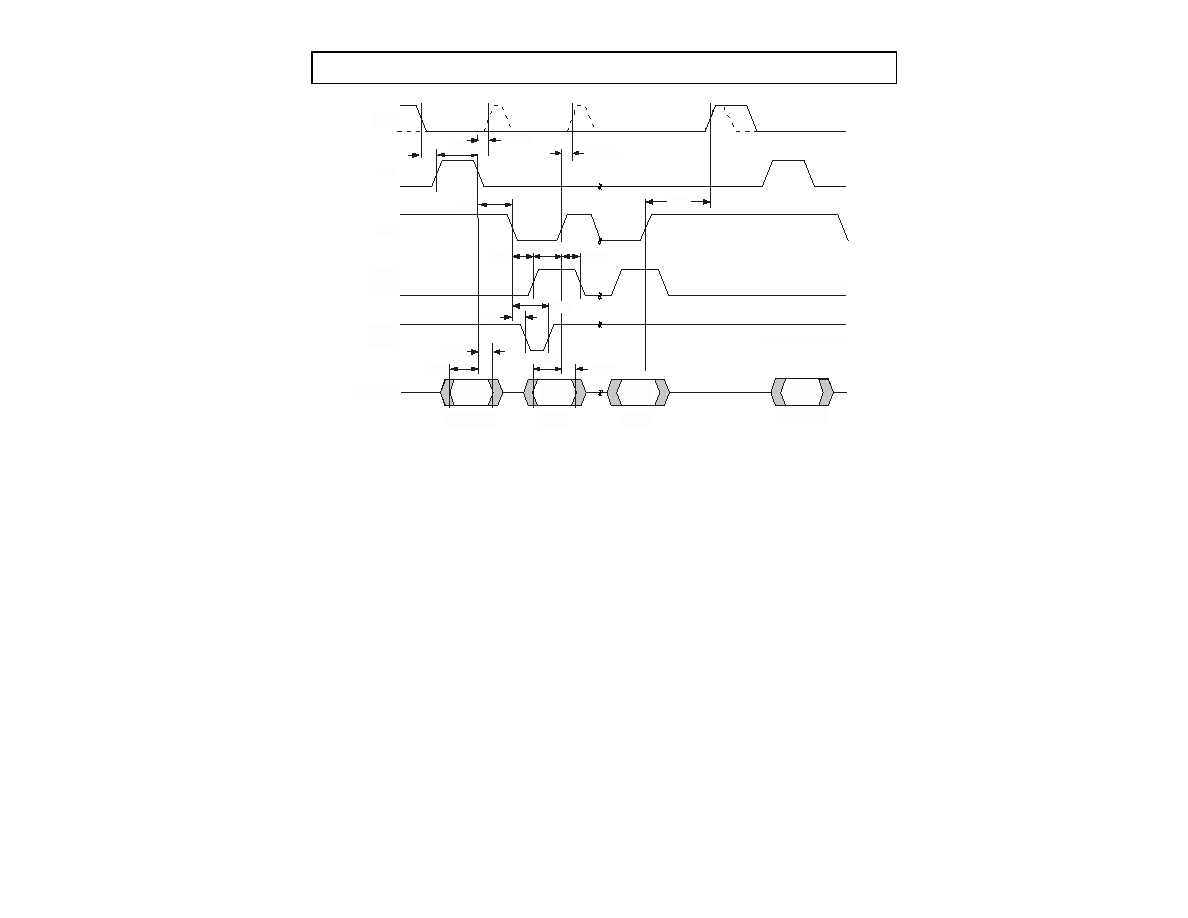
27
REV. 0
ADSP-2191M
Figure 14. Host Port ALE Mode Write Cycle Timing
AD DR ESS
VA LI D
A DDR ESS
VA LI D
t
A LA H
DA TA
VAL I D
DAT A
VA LI D
L AST
BYT E
FI RST
BYT E
ST ART
NEXT WO R D
STA RT
F I RST W OR D
t
WD H
t
A A LS
t
D WS
t
WH K S
t
WH KH
HA CK EACH BYT E
H AC K F I RST B YTE
t
A LPW
t
A LC SW
t
A LW
t
H K WD
t
WC SW
t
WH S
t
WH H
HAD150
HA16
HWR
HALE
H ACK
(ACK
MO DE)
HACK
(READY
M ODE)
t
C SA L
H CMS
HIOMS
t
WC S

ADSP-2191M
28
REV. 0
Host Port ACC Mode Write Cycle Timing
Table 16
and
Figure 15
describe Host port write operations in Address Cycle Control (ACC) mode. For more information on ACK,
Ready, ALE, and ACC mode selection, see the Host port modes description
on page 8
.
Table 16. Host Port ACC Mode Write Cycle Timing
Parameter
Min
Max
Unit
Switching Characteristics
t
WHKS1
HWR Asserted to HACK Asserted (ACK Mode) First Byte
10
5t
HCLK
+t
NH
1
1
t
NH
are peripheral bus latencies (n
t
HCLK
); these are internal DSP latencies related to the number of peripheral DMAs attempting to access DSP memory
at the same time.
ns
t
WHKS2
HWR Asserted to HACK Asserted (Setup, ACK Mode)
2
2
Measurement is for the second, third, or fourth byte of a host write transaction. The quantity of bytes to complete a host write transaction is dependent
on the data bus size (8 or 16 bits) and the data type (16 or 24 bits).
12
ns
t
WHKH
HWR Deasserted to HACK Deasserted (Hold, ACK Mode)
10
ns
t
WHS
HWR Asserted to HACK Asserted (Setup, Ready Mode)
10
ns
t
WHH
HWR Asserted to HACK Deasserted (Hold, Ready Mode)
First Byte
0
5t
HCLK
+t
NH
1
ns
t
WSHKS
HWR Asserted to HACK Asserted (Setup) During Address
Latch
10
ns
t
WHHKH
HWR Deasserted to HACK Deasserted (Hold) During
Address Latch
10
ns
Timing Requirements
t
WAL
HWR Asserted to HALE Deasserted (Delay)
1.5
ns
t
CSAL
HCMS or HCIOMS Asserted to HALE Asserted (Delay)
0
ns
t
ALCS
HALE Deasserted to Optional
HCMS or HCIOMS
Deasserted
1
ns
t
WCSW
HWR Deasserted to HCMS or HCIOMS Deasserted
0
ns
t
ALW
HALE Asserted to HWR Asserted
0.5
ns
t
CSW
HCMS or HCIOMS Asserted to HWR Asserted
0
ns
t
WCS
HWR Deasserted (After Last Byte) to HCMS or
HCIOMS Deasserted (Ready for Next Write)
0
ns
t
ALEW
HALE Deasserted to HWR Asserted
1
ns
t
HKWD
HACK Asserted to
HWR Deasserted (Hold, ACK Mode)
1.5
ns
t
ADW
Address Valid to
HWR Asserted (Setup)
3
ns
t
WAD
HWR Deasserted to Address Invalid (Hold)
3
ns
t
DWS
Data Valid to
HWR Deasserted (Setup)
2
ns
t
WDH
HWR Deasserted to Data Invalid (Hold)
2
ns
t
HKWAL
HACK Asserted to
HWR Deasserted (Hold) During Address
Latch
2
2
ns
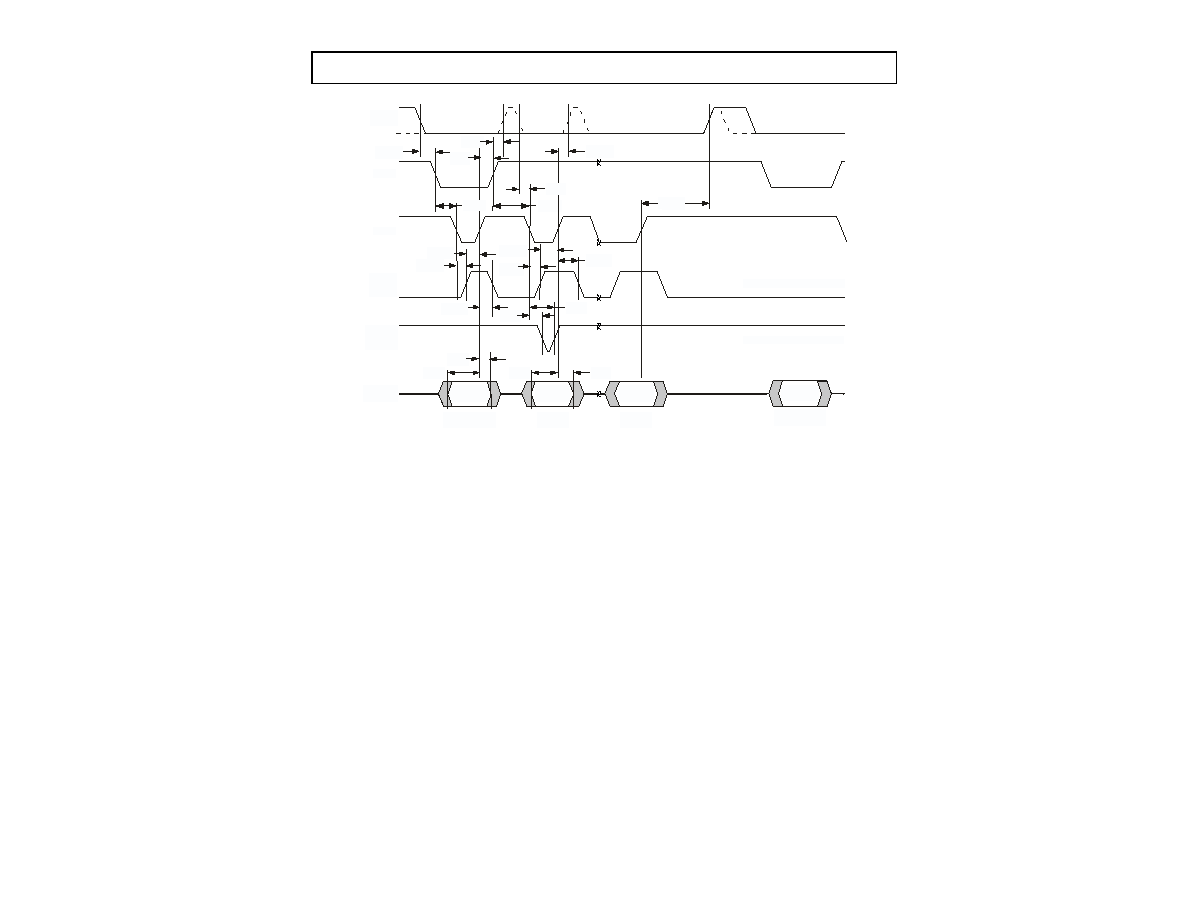
29
REV. 0
ADSP-2191M
Figure 15. Host Port ACC Mode Write Cycle Timing
AD DR ESS
VA LI D
D ATA
VAL I D
DA TA
VALI D
A DDR ESS
VA LI D
H ACK FI R ST B YTE
t
WD H
H A D15 0
H A 16
t
WA D
LA ST
BYTE
F I RST
B YTE
S TAR T
NEX T WO RD
ST AR T
FI R ST WO RD
t
A D W
t
D WS
t
WH K H
t
W H K S
t
C S A L
t
WC S
HWR
H AL E
HCMS
HIOMS
t
ALE W
HACK
( ACK
MO D E)
t
H K W D
H AC K EAC H B YTE
HACK
(R EA DY
M OD E)
t
WA L
t
A LC S
t
A LW
t
C S W
t
WC SW
t
WH S
t
WH H
t
WH H KH
t
W S H K S
t
H K W A L

ADSP-2191M
30
REV. 0
Host Port ALE Mode Read Cycle Timing
Table 17
and
Figure 16
describe Host port read operations in Address Latch Enable (ALE) mode. For more information on ACK,
Ready, ALE, and ACC mode selection, see the Host port modes description
on page 8
.
Table 17. Host Port ALE Mode Read Cycle Timing
Parameter
Min
Max
Unit
Switching Characteristics
t
RHKS1
HRD Asserted to HACK Asserted (ACK Mode) First Byte
12t
HCLK
15t
HCLK
+t
NH
1
1
t
NH
are peripheral bus latencies (n
t
HCLK
); these are internal DSP latencies related to the number of peripherals attempting to access DSP memory at
the same time.
ns
t
RHKS2
HRD Asserted to HACK Asserted (Setup, ACK Mode)
2
2
Measurement is for the second, third, or fourth byte of a host read transaction. The quantity of bytes to complete a host read transaction is dependent on
the data bus size (8 or 16 bits) and the data type (16 or 24 bits).
12
ns
t
RHKH
HRD Deasserted to HACK Deasserted (Hold, ACK Mode)
10
ns
t
RHS
HRD Asserted to HACK Asserted (Setup, Ready Mode)
10
ns
t
RHH
HRD Asserted to HACK Deasserted (Hold, Ready Mode)
First Byte
12t
HCLK
15t
HCLK
+t
NH
1
ns
t
RDH
HRD Deasserted to Data Invalid (Hold)
1
ns
t
RDD
HRD Deasserted to Data Disable
10
ns
Timing Requirements
t
CSAL
HCMS or HCIOMS Asserted to HALE Asserted (Delay)
0
ns
t
ALCS
HALE Deasserted to Optional
HCMS or HCIOMS
Deasserted
1
ns
t
RCSW
HRD Deasserted to HCMS or HCIOMS Deasserted
0
ns
t
ALR
HALE Deasserted to
HRD Asserted
5
ns
t
RCS
HRD Deasserted (After Last Byte) to HCMS or
HCIOMS Deasserted (Ready for Next Read)
0
ns
t
ALPW
HALE Asserted Pulsewidth
4
ns
t
HKRD
HACK Asserted to
HRD Deasserted (Hold, ACK Mode)
1.5
ns
t
AALS
Address Valid to HALE Deasserted (Setup)
2
ns
t
ALAH
HALE Deasserted to Address Invalid (Hold)
4
ns
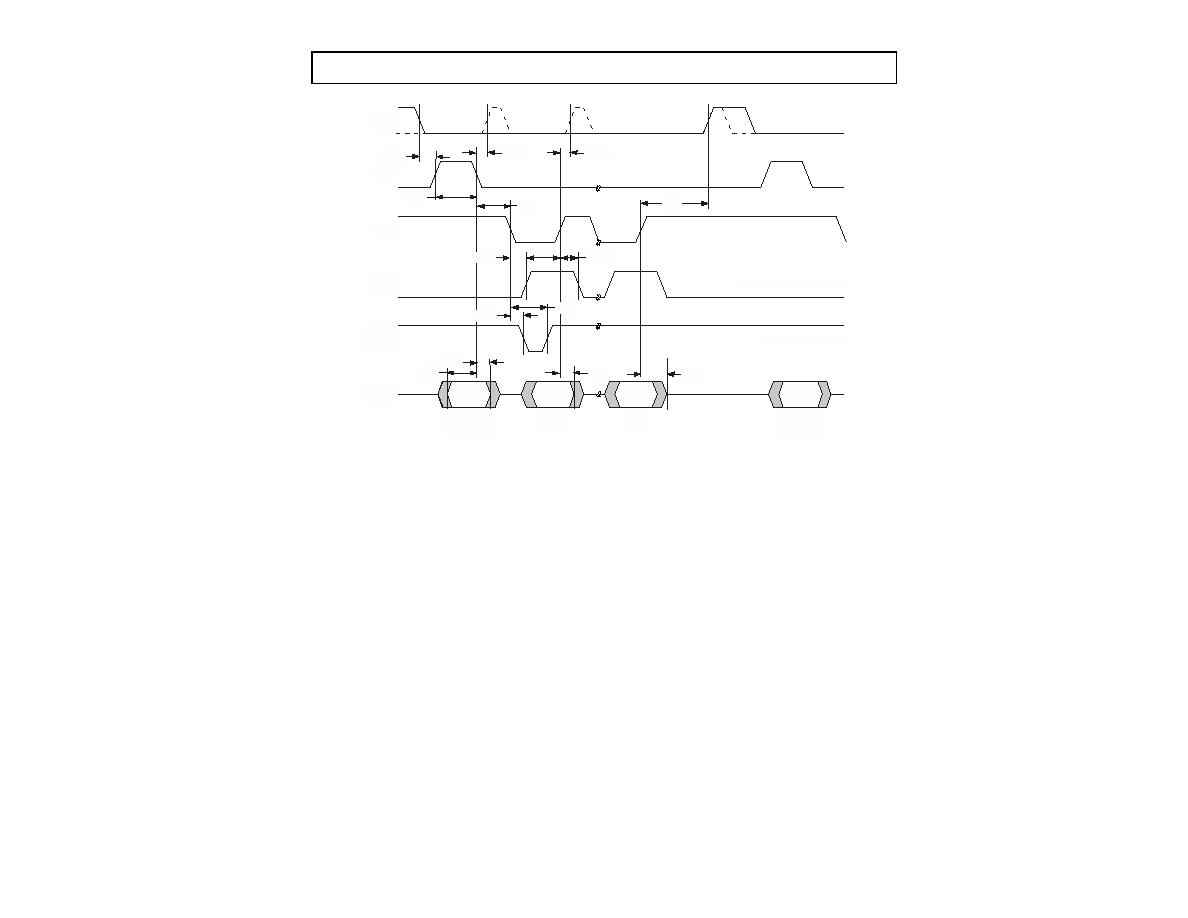
31
REV. 0
ADSP-2191M
Figure 16. Host Port ALE Mode Read Cycle Timing
t
H K R D
AD DR ESS
VA LI D
AD DR ESS
VAL I D
t
A L A H
D AT A
VA LI D
D ATA
VAL I D
L A ST
B YTE
F I RST
B YTE
STA RT
NEXT
WO RD
ST A RT
F I RST
WO RD
t
R D H
t
A A LS
t
R C S
t
R H K H
HAC K
(R EAD Y
MO DE)
HA C K FO R EACH BYT E
t
A LPW
t
A LC S
t
A L R
t
R C S W
HA CK FI RST BYT E
t
R H S
t
R H H
t
R H K S
t
R D D
H A D150
H A16
t
C S A L
HRD
H ALE
HCMS
HIOMS
HACK
( ACK
MO D E)

ADSP-2191M
32
REV. 0
Host Port ACC Mode Read Cycle Timing
Table 18
and
Figure 17
describe Host port read operations in Address Cycle Control (ACC) mode. For more information on ACK,
Ready, ALE, and ACC mode selection, see the Host port modes description
on page 8
.
Table 18. Host Port ACC Mode Read Cycle Timing
Parameter
Min
Max
Unit
Switching Characteristics
t
RHKS1
HRD Asserted to HACK Asserted (ACK Mode) First Byte
12t
HCLK
15t
HCLK
+t
NH
1
1
t
NH
are peripheral bus latencies (n
t
HCLK
); these are internal DSP latencies related to the number of peripherals attempting to access DSP memory at
the same time.
ns
t
RHKS2
HRD Asserted to HACK Asserted (Setup, ACK Mode)
2
2
Measurement is for the second, third, or fourth byte of a host read transaction. The quantity of bytes to complete a host read transaction is dependent on
the data bus size (8 or 16 bits) and the data type (16 or 24 bits).
10
ns
t
RHKH
HRD Deasserted to HACK Deasserted (Hold, ACK Mode)
10
ns
t
RHS
HRD Asserted to HACK Asserted (Setup, Ready Mode)
10
ns
t
RHH
HRD Asserted to HACK Deasserted (Hold, Ready Mode)
First Byte
12t
HCLK
15t
HCLK
+t
NH
1
ns
t
RDH
HRD Deasserted to Data Invalid (Hold)
1
ns
t
WSHKS
HWR Asserted to HACK Asserted (Setup) During Address
Latch
10
ns
t
WHHKH
HWR Deasserted to HACK Deasserted (Hold) During
Address Latch
10
ns
t
RDD
HRD Deasserted to Data Disable
10
ns
Timing Requirements
t
CSAL
HCMS or HCIOMS Asserted to HALE Asserted (Delay)
0
ns
t
ALCS
HALE Deasserted to Optional
HCMS or HCIOMS
Deasserted
1
ns
t
RCSW
HRD Deasserted to HCMS or HCIOMS Deasserted
0
ns
t
ALW
HALE Asserted to HWR Asserted
0.5
ns
t
ALER
HALE Deasserted to HWR Asserted
1
ns
t
CSR
HCMS or HCIOMS Asserted to HRD Asserted
0
ns
t
RCS
HRD Deasserted (After Last Byte) to HCMS or
HCIOMS Deasserted (Ready for Next Read)
0
ns
t
WAL
HWR Deasserted to HALE Deasserted (Delay)
2.5
ns
t
HKRD
HACK Asserted to
HRD Deasserted (Hold, ACK Mode)
1.5
ns
t
ADW
Address Valid to
HWR Deasserted (Setup)
2
ns
t
WAD
HWR Deasserted to Address Invalid (Hold)
1
ns
t
HKWAL
HACK Asserted to
HWR Deasserted (Hold) During Address
Latch
2
2
ns
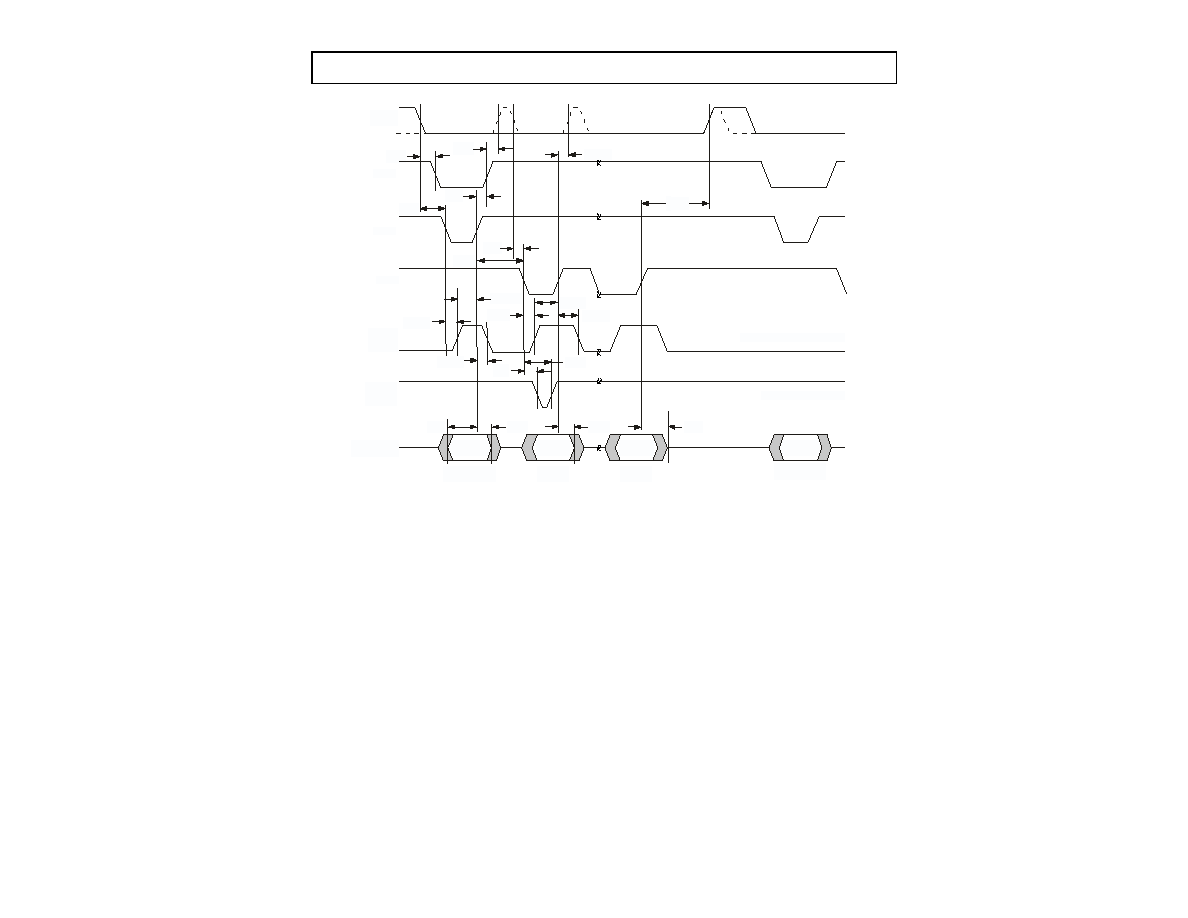
33
REV. 0
ADSP-2191M
Figure 17. Host Port ACC Mode Read Cycle Timing
A DD RESS
VA L I D
D ATA
VAL I D
D ATA
VAL I D
A DD RESS
VALI D
t
R D H
HAD 150
HA16
t
WA D
t
A D W
LA ST
BYTE
F I RST
B YTE
S TAR T
NEX T WO RD
ST AR T
FI R ST WO RD
t
R H K H
t
H K R D
t
C SA L
t
R H K S
t
R C S
HWR
HALE
HCMS
HIOMS
t
A LW
HACK
(ACK
MODE)
HA CK EA C H BYT E
HRD
t
A LC S
t
C S R
t
A LE R
t
R C S W
H ACK
(READY
MO DE)
H A CK F I RST BYT E
t
R H S
t
R H H
t
WSH K S
t
WH H K H
t
H K WA L
t
R D D
t
WA L

ADSP-2191M
34
REV. 0
Serial Ports
Table 19
and
Figure 18
describe SPORT transmit and receive operations, while
Figure 19
and
Figure 20
describe SPORT Frame
Sync operations.
Table 19. Serial Ports
1, 2
1
To determine whether communication is possible between two devices at clock speed n, the following specifications must be confirmed: 1) frame sync delay
and frame sync setup-and-hold, 2) data delay and data setup-and-hold, and 3) SCLK width.
2
Word selected timing for I
2
S mode is the same as TFS/RFS timing (normal framing only).
Parameter
Min
Max
Unit
External Clock
Timing Requirements
t
SFSE
TFS/RFS Setup Before TCLK/RCLK
3
3
Referenced to sample edge.
4
ns
t
HFSE
TFS/RFS Hold After TCLK/RCLK
3
4
ns
t
SDRE
Receive Data Setup Before RCLK
3
1.5
ns
t
HDRE
Receive Data Hold After RCLK
3
4
ns
t
SCLKW
TCLK/RCLK Width
0.5t
HCLK
1
ns
t
SCLK
TCLK/RCLK Period
2t
HCLK
ns
Internal Clock
Timing Requirements
t
SFSI
TFS Setup Before TCLK
4
; RFS Setup Before RCLK
3
4
Referenced to drive edge.
4
ns
t
HFSI
TFS/RFS Hold After TCLK/RCLK
3
3
ns
t
SDRI
Receive Data Setup Before RCLK
3
2
ns
t
HDRI
Receive Data Hold After RCLK
3
5
ns
External or Internal Clock
Switching Characteristics
t
DFSE
TFS/RFS Delay After TCLK/RCLK (Internally
Generated FS)
4
14
ns
t
HOFSE
TFS/RFS Hold After TCLK/RCLK (Internally
Generated FS)
4
3
ns
External Clock
Switching Characteristics
t
DDTE
Transmit Data Delay After TCLK
4
13.4
ns
t
HDTE
Transmit Data Hold After TCLK
4
4
ns
Internal Clock
Switching Characteristics
t
DDTI
Transmit Data Delay After TCLK
4
13.4
ns
t
HDTI
Transmit Data Hold After TCLK
4
4
ns
t
SCLKIW
TCLK/RCLK Width
0.5t
HCLK
3.5
0.5t
HCLK
+ 2.5
ns
Enable and Three-State
5
5
Only applies to SPORT0/1.
Switching Characteristics
t
DTENE
Data Enable from External TCLK
4
0
12.1
ns
t
DDTTE
Data Disable from External TCLK
4
13
ns
t
DTENI
Data Enable from Internal TCLK
4
0
13
ns
t
DDTTI
Data Disable from External TCLK
4
12
ns
External Late Frame Sync
Switching Characteristics
t
DDTLFSE
Data Delay from Late External TFS with MCE = 1, MFD = 0
6, 7
6
MCE = 1, TFS enable, and TFS valid follow t
DDTENFS
and t
DDTLFSE
.
7
If external RFSD/TFS setup to RCLK/TCLK > 0.5t
LSCK
, t
DDTLSCK
and t
DTENLSCK
apply; otherwise t
DDTLFSE
and t
DTENLFS
apply.
10.5
ns
t
DTENLFSE
Data Enable from Late FS or MCE = 1, MFD = 0
6, 7
3.5
ns

35
REV. 0
ADSP-2191M
Figure 18. Serial Ports
DT
DT
t
DDTTE
t
DDTEN
t
DDTTI
t
DDTIN
DRIVE
EDGE
DRIVE
EDGE
DRIVE
EDGE
DRIVE
EDGE
TCLK / RCLK
TCLK / RCLK
TCLK (EXT)
TFS ("LATE," EXT.)
t
SDRI
RCLK
RFS
DR
DRIVE
EDGE
SAMPLE
EDGE
t
HDRI
t
SFSI
t
HFSI
t
DFSE
t
HOFSE
t
SCLKIW
DATA RECEIVE-INTERNAL CLOCK
t
SDRE
DATA RECEIVE-EXTERNAL CLOCK
RCLK
RFS
DR
DRIVE
EDGE
SAMPLE
EDGE
t
HDRE
t
SFSE
t
HFSE
t
DFSE
t
SCLKW
t
HOFSE
NOTE: EITHER THE RISING EDGE OR FALLING EDGE OF RCLK OR TCLK CAN BE USED AS THE ACTIVE SAMPLING EDGE.
t
DDTI
t
HDTI
TCLK
TFS
DT
DRIVE
EDGE
SAMPLE
EDGE
t
SFSI
t
HFSI
t
SCLKIW
t
DFSE
t
HOFSE
DATA TRANSMIT-INTERNAL CLOCK
t
DDTE
t
HDTE
TCLK
TFS
DT
DRIVE
EDGE
SAMPLE
EDGE
t
SFSE
t
HFSE
t
DFSE
t
SCLKW
t
HOFSE
DATA TRANSMIT-EXTERNAL CLOCK
NOTE: EITHER THE RISING EDGE OR FALLING EDGE OF RCLK OR TCLK CAN BE USED AS THE ACTIVE SAMPLING EDGE.
TCLK (INT)
TFS ("LATE," INT.)
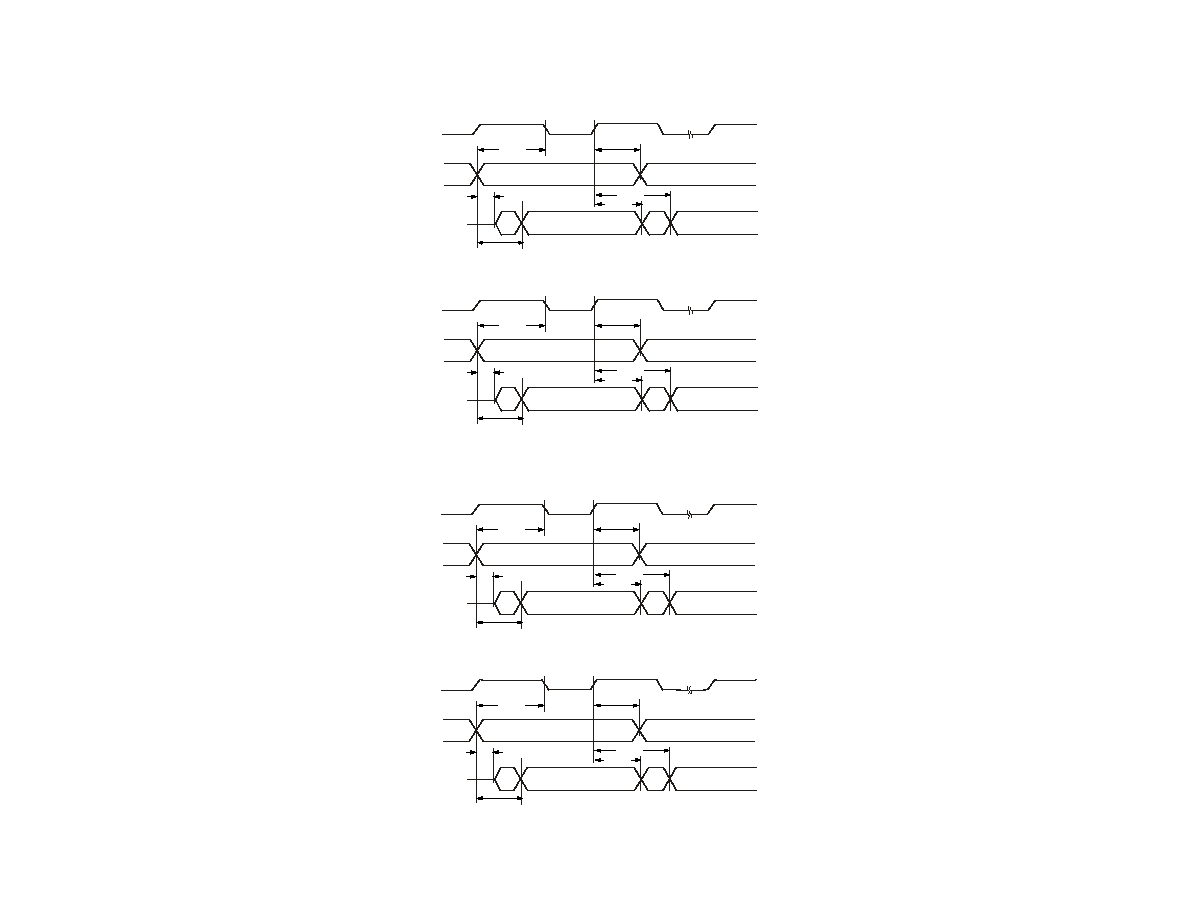
ADSP-2191M
36
REV. 0
Figure 19. Serial Ports--External Late Frame Sync (Frame Sync Setup > 0.5t
SCLK
)
Figure 20. Serial Ports--External Late Frame Sync (Frame Sync Setup < 0.5t
HCLK
)
t
SFSE/ I
DRIVE
SAMPLE
DRIVE
t
DTENLFSE
t
DDTLFSE
EXTERNAL RFS WITH MCE = 1, MFD = 0
1ST BIT
2ND BIT
DT
RCLK
RFS
LATE EXTERNAL TFS
t
HDTE/ I
t
DDTE/ I
t
SFSE/ I
DRIVE
SAMPLE
DRIVE
t
DTENLFSE
t
DDTLFSE
1ST BIT
2ND BIT
DT
TCLK
TFS
t
HDTE/ I
t
DDTE/ I
t
HOSFSE/ I
t
HOSFSE/ I
t
SFSE/ I
DRIVE
SAMPLE
DRIVE
t
DTENLFSE
t
DDTLFSE
EXTERNAL RFS WITH MCE = 1, MFD = 0
1ST BIT
2ND BIT
DT
RCLK
RFS
LATE EXTERNAL TFS
t
HDTE/ I
t
DDTE/ I
t
SFSE/ I
DRIVE
SAMPLE
DRIVE
t
DTENLFSE
t
DDTLFSE
1ST BIT
2ND BIT
DT
TCLK
TFS
t
HDTE/ I
t
DDTE/ I
t
HOFSE/ I
t
HOFSE/ I
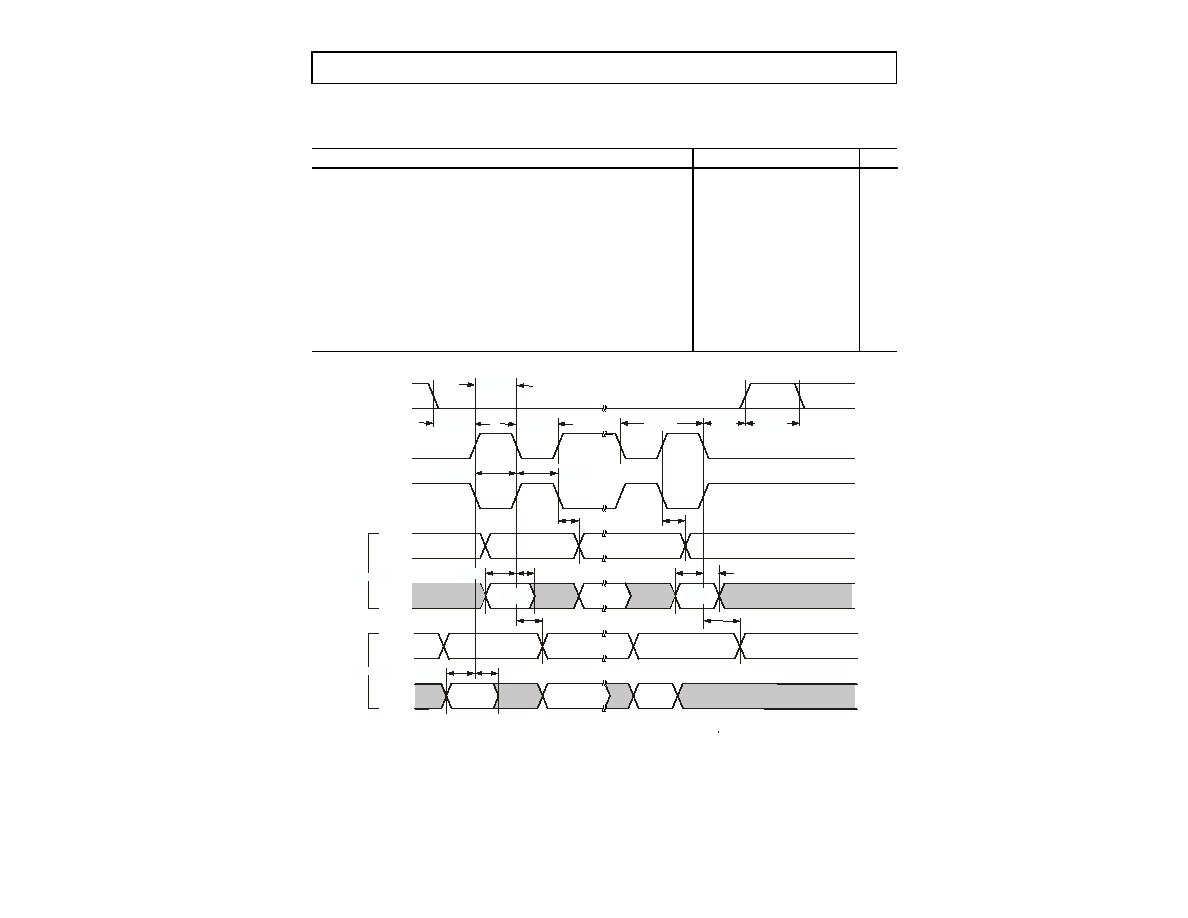
37
REV. 0
ADSP-2191M
Serial Peripheral Interface (SPI) Port--Master Timing
Table 20
and
Figure 21
describe SPI port master operations.
Table 20. Serial Peripheral Interface (SPI) Port--Master Timing
Parameter
Min
Max
Unit
Switching Characteristics
t
SDSCIM
SPIxSEL Low to First SCLK edge (x=0 or 1)
2t
HCLK
3
ns
t
SPICHM
Serial Clock High Period
2t
HCLK
3
ns
t
SPICLM
Serial Clock Low Period
2t
HCLK
3
ns
t
SPICLK
Serial Clock Period
4t
HCLK
1
ns
t
HDSM
Last SCLK Edge to
SPIxSEL High (x=0 or 1)
2t
HCLK
3
ns
t
SPITDM
Sequential Transfer Delay
2t
HCLK
2
ns
t
DDSPID
SCLK Edge to Data Output Valid (Data Out Delay)
0
6
ns
t
HDSPID
SCLK Edge to Data Output Invalid (Data Out Hold)
0
5
ns
Timing Requirements
t
SSPID
Data Input Valid to SCLK Edge (Data Input Setup)
8
ns
t
HSPID
SCLK Sampling Edge to Data Input Invalid (Data In Hold)
1
ns
Figure 21. Serial Peripheral Interface (SPI) Port--Master Timing
t
S S P I D
t
H S P I D
t
H D S P I D
L S B
M S B
t
H S P I D
t
D D S P I D
M OS I
( OU T PU T )
MI S O
(I N P U T)
SPIxSEL
( O U T PU T )
(x = 0 o r 1 )
SC LK
(C P O L = 0 )
(O U T P U T )
SC L K
(C P OL = 1 )
(O U T P U T )
t
S P I C H M
t
S P I C L M
t
S P I C L M
t
S P I C L K
t
S P I C H M
t
H D S M
t
S P I T D M
t
H D S P I D
L S B
V A L I D
L S B
MS B
M S B
V A L I D
t
H S P I D
t
D D S P I D
M O S I
( OU T P U T )
M I S O
(I N PU T )
t
S S P I D
CPHA = 0
M S B
V A L I D
t
S D S C I M
t
S S P I D
L S B
V A L I D
CPHA = 1

ADSP-2191M
38
REV. 0
Serial Peripheral Interface (SPI) Port--Slave Timing
Table 21
and
Figure 22
describe SPI port slave operations.
Table 21. Serial Peripheral Interface (SPI) Port--Slave Timing
Parameter
Min
Max
Unit
Switching Characteristics
t
DSOE
SPISS Assertion to Data Out Active
0
8
ns
t
DSDHI
SPISS Deassertion to Data High Impedance
0
10
ns
t
DDSPID
SCLK Edge to Data Out Valid (Data Out Delay)
0
10
ns
t
HDSPID
SCLK Edge to Data Out Invalid (Data Out Hold)
0
10
ns
Timing Requirements
t
SPICHS
Serial Clock High Period
2t
HCLK
ns
t
SPICLS
Serial Clock Low Period
2t
HCLK
ns
t
SPICLK
Serial Clock Period
4t
HCLK
ns
t
HDS
Last SPICLK Edge to
SPISS Not Asserted
2t
HCLK
ns
t
SPITDS
Sequential Transfer Delay
2t
HCLK
+ 4
ns
t
SDSCI
SPISS Assertion to First SPICLK Edge
2t
HCLK
ns
t
SSPID
Data Input Valid to SCLK Edge (Data Input Setup)
1.6
ns
t
HSPID
SCLK Sampling Edge to Data Input Invalid (Data In Hold)
2.4
ns
Figure 22. Serial Peripheral Interface (SPI) Port--Slave Timing
t
HSPID
t
DDSPID
t
DSDHI
LSB
MSB
MSB
VALID
t
HSPID
t
DSOE
t
DDSPID
t
HDSPID
MISO
(OUTPUT)
MOSI
(INPUT)
t
SSPID
SPISS
(INPUT)
SCLK
(CPOL = 0)
(INPUT)
SCLK
(CPOL = 1)
(INPUT)
t
SDSCI
t
SPICHS
t
SPICLS
t
SPICLS
t
SPICLK
t
HDS
t
SPICHS
t
SSPID
t
HSPID
t
DSDHI
LSB
VALID
MSB
MSB
VALID
t
DSOE
t
DDSPID
MISO
(OUTPUT)
MOSI
(INPUT)
t
SSPID
LSB
VALID
LSB
t
SPITDS
CPHA = 0
CPHA = 1

39
REV. 0
ADSP-2191M
Universal Asynchronous Receiver-Transmitter (UART) Port--Receive and Transmit Timing
Figure 23
describes UART port receive and transmit operations. The maximum baud rate is HCLK/16. As shown in
Figure 23
there
is some latency between the generation internal UART interrupts and the external data operations. These latencies are negligible at
the data transmission rates for the UART.
Figure 23. UART Port--Receive and Transmit Timing
RXD
DATA(58)
INTERNAL
UART RECEIVE
INTERRUPT
UART RECEIVE BIT SET BY DATA STOP;
CLEARED BY FIFO READ
HCLK
(SAMPLE
CLOCK)
TXD
DATA(58)
STOP (12)
INTERNAL
UART TRANSMIT
INTERRUPT
UART TRANSMIT BIT SET BY PROGRAM;
CLEARED BY WRITE TO TRANSMIT
START
STOP
TRANSMIT
RECEIVE
AS DATA
WRITTEN TO
BUFFER
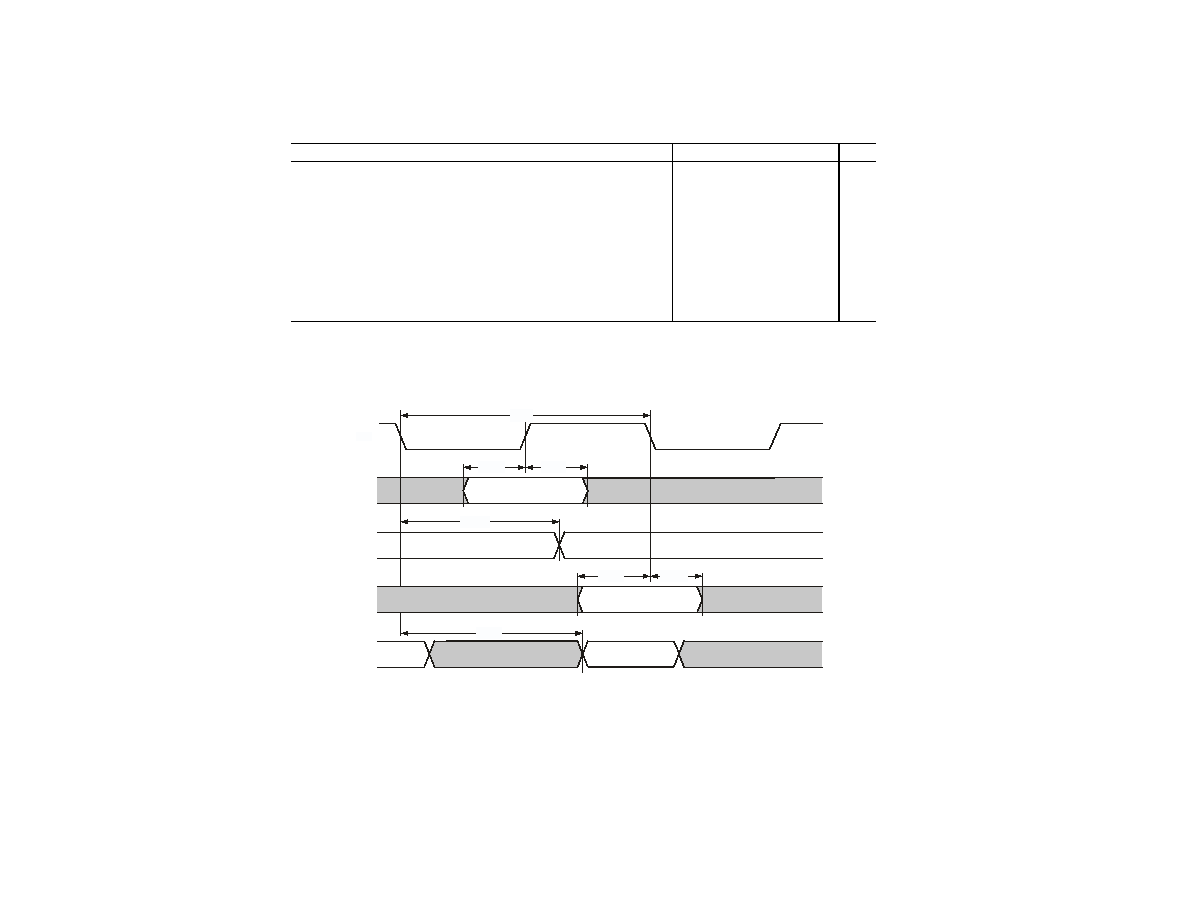
ADSP-2191M
40
REV. 0
JTAG Test And Emulation Port Timing
Table 22
and
Figure 24
describe JTAG port operations.
Table 22. JTAG Port Timing
Parameter
Min
Max
Unit
Switching Characteristics
t
DTDO
TDO Delay from TCK Low
8
ns
t
DSYS
System Outputs Delay After TCK Low
1
0
22
ns
Timing Requirements
t
TCK
TCK Period
20
ns
t
STAP
TDI, TMS Setup Before TCK High
4
ns
t
HTAP
TDI, TMS Hold After TCK High
4
ns
t
SSYS
System Inputs Setup Before TCK Low
2
4
ns
t
HSYS
System Inputs Hold After TCK Low
2
5
ns
t
TRSTW
TRST Pulsewidth
3
4t
TCK
ns
1
System Outputs = DATA150, ADDR210,
MS30, RD, WR, ACK, CLKOUT, BG, PF70, TIMEXP, DT0, DT1, TCLK0, TCLK1, RCLK0, RCLK1,
TFS0, TFS1, RFS0, RFS1,
BMS.
2
System Inputs = DATA150, ADDR210,
RD, WR, ACK, BR, BG, PF70, DR0, DR1, TCLK0, TCLK1, RCLK0, RCLK1, TFS0, TFS1, RFS0, RFS1,
CLKIN,
RESET.
3
50 MHz max.
Figure 24. JTAG Port Timing
TMS
TDI
TD O
S YSTE M
INPUTS
S YSTE M
O UTPUTS
TCK
t
T C K
t
H T A P
t
S T A P
t
D T D O
t
SS Y S
t
H S Y S
t
D S Y S
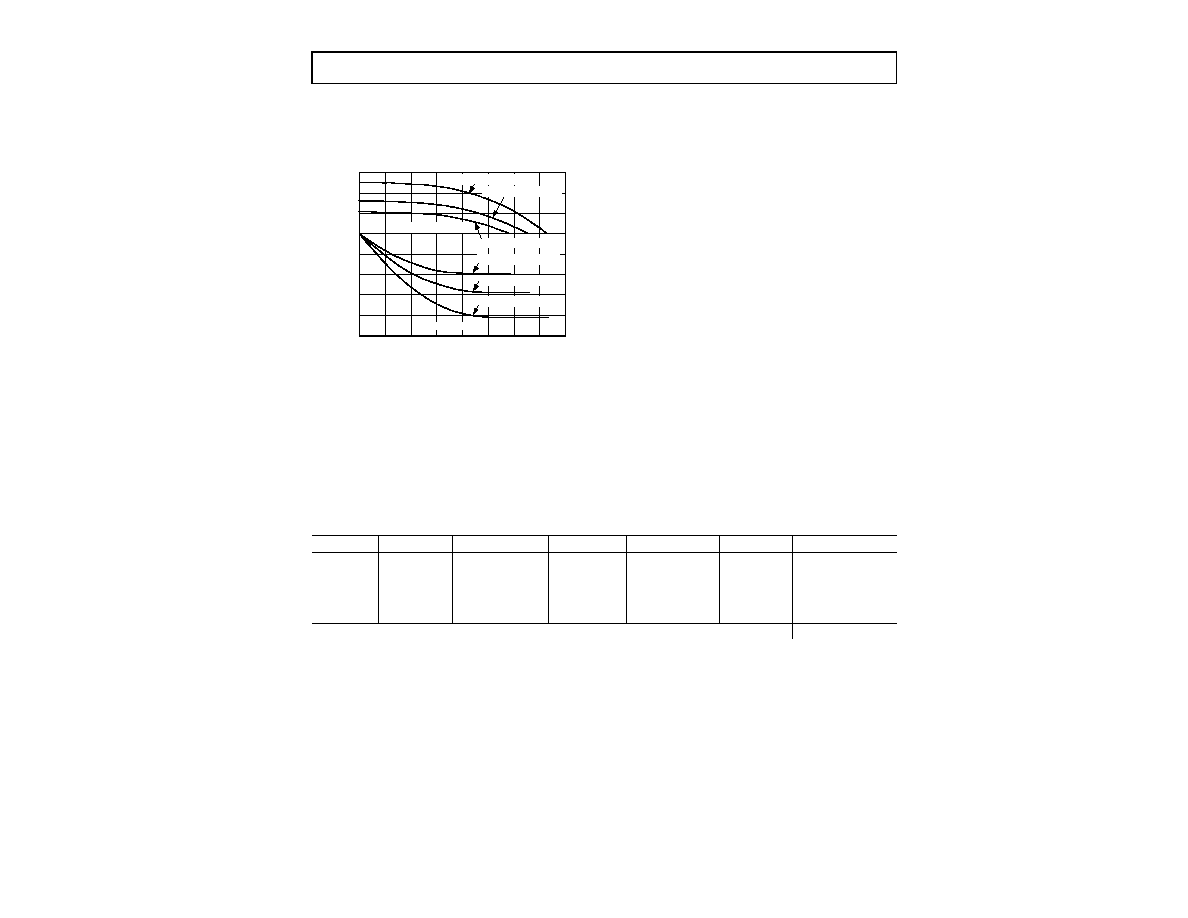
41
REV. 0
ADSP-2191M
Output Drive Currents
Figure 25
shows typical I-V characteristics for the output drivers
of the ADSP-2191M. The curves represent the current drive
capability of the output drivers as a function of output voltage.
Power Dissipation
Total power dissipation has two components, one due to internal
circuitry and one due to the switching of external output drivers.
Internal power dissipation is dependent on the instruction
execution sequence and the data operands involved.
The external component of total power dissipation is caused by
the switching of output pins. Its magnitude depends on:
·
Number of output pins that switch during each cycle (O)
·
The maximum frequency at which they can switch (f)
·
Their load capacitance (C)
·
Their voltage swing (V
DD
)
and is calculated by the formula below.
The load capacitance includes the processor's package capaci-
tance (C
IN
). The switching frequency includes driving the load
high and then back low. Address and data pins can drive high and
low at a maximum rate of 1/(2t
CK
). The write strobe can switch
every cycle at a frequency of 1/t
CK
. Select pins switch at 1/(2t
CK
),
but selects can switch on each cycle. For example, estimate P
EXT
with the following assumptions:
·
A system with one bank of external data memory--asyn-
chronous RAM (16-bit)
·
One 64K 16 RAM chip is used with a load of 10 pF
·
Maximum peripheral speed CCLK = 80 MHz, HCLK =
80 MHz
·
External data memory writes occur every other cycle, a
rate of 1/(4t
HCLK
), with 50% of the pins switching
·
The bus cycle time is 80 MHz (t
HCLK
= 12.5 nsec)
The P
EXT
equation is calculated for each class of pins that can
drive as shown in
Table 23
.
A typical power consumption can now be calculated for these
conditions by adding a typical internal power dissipation with the
following formula.
Where:
·
P
EXT
is from
Table 23
·
P
INT
is I
DDINT
2.5 V, using the calculation I
DDINT
listed in
Power Dissipation on page 41
.
Note that the conditions causing a worst-case P
EXT
are different
from those causing a worst-case P
INT
. Maximum P
INT
cannot
occur while 100% of the output pins are switching from all ones
to all zeros. Note also that it is not common for an application to
have 100% or even 50% of the outputs switching simultaneously.
Test Conditions
The DSP is tested for output enable, disable, and hold time.
Output Disable Time
Output pins are considered to be disabled when they stop driving,
go into a high impedance state, and start to decay from their
output high or low voltage. The time for the voltage on the bus
to decay by V is dependent on the capacitive load, C
L
and the
load current, I
L
. This decay time can be approximated by the
equation below.
Figure 25. Typical Drive Currents
SOURCE (
VDDEXT
) VOLTAGE V
0
3.5
0.5
1.0
1.5
2.0
2.5
3.0
S
O
U
R
C
E
(
V
D
D
E
X
T
)
C
U
R
R
E
N
T
m
A
100
80
60
40
20
0
20
40
60
4.0
V
DDEXT
= 3.65V @
40°C
V
DDEXT
= 3.3V @
+ 25°C
V
DDEXT
= 3.0V @
+ 85°C
V
OH
V
OL
V
DDEXT
= 3.0V @
+ 85°C
V
DDEXT
= 3.3V @
+ 25°C
V
DDEXT
= 3.65V @
40°C
INPUT CURRENT
OUTPUT CURRENT
P
EXT
O
C
×
V
DD
2
×
f
×
=
Table 23. P
EXT
Calculation Example
Pin Type
# of Pins
% Switching
C
f
V
DD
2
= P
EXT
Address
15
50
10 pF
20 MHz
10.9 V
= .01635 W
MSx
1
0
10 pF
20 MHz
10.9 V
= 0 W
WR
1
--
10 pF
40 MHz
10.9 V
= .00436 W
Data
16
50
10 pF
20 MHz
10.9 V
= .01744 W
CLKOUT
1
--
10 pF
80 MHz
10.9 V
= .00872 W
P
EXT
= .04687 W
P
TOTAL
P
=
EXT
P
INT
+
t
DECAY
C
L
V
I
L
---------------
=

ADSP-2191M
42
REV. 0
The output disable time t
DIS
is the difference between
t
MEASURED
and t
DECAY
as shown in
Figure 26
. The time
t
MEASURED
is the interval from when the reference signal
switches to when the output voltage decays V from the measured
output high or output low voltage. The t
DECAY
is calculated with
test loads C
L
and I
L
, and with V equal to 0.5 V.
Output Enable Time
Output pins are considered to be enabled when they have made
a transition from a high impedance state to when they start
driving. The output enable time t
ENA
is the interval from when
a reference signal reaches a high or low voltage level to when the
output has reached a specified high or low trip point, as shown
in the Output Enable/Disable diagram (
Figure 26
). If multiple
pins (such as the data bus) are enabled, the measurement value
is that of the first pin to start driving.
Example System Hold Time Calculation
To determine the data output hold time in a particular system,
first calculate t
DECAY
using the equation at
Output Disable Time
on page 41
. Choose V to be the difference between the
ADSP-2191M's output voltage and the input threshold for the
device requiring the hold time. A typical V will be 0.4 V. C
L
is
the total bus capacitance (per data line), and I
L
is the total leakage
or three-state current (per data line). The hold time will be
t
DECAY
plus the minimum disable time (i.e., t
DATRWH
for the
write cycle).
Capacitive Loading
Output delays and holds are based on standard capacitive loads:
50 pF on all pins (see
Figure 30
). The delay and hold specifica-
tions given should be derated by a factor of 1.5 ns/50 pF for loads
other than the nominal value of 50 pF.
Figure 28
and
Figure 29
show how output rise time varies with capacitance. These figures
also show graphically how output delays and holds vary with load
capacitance. (Note that this graph or derating does not apply to
output disable delays; see
Output Disable Time on page 41
.) The
graphs in these figures may not be linear outside the ranges
shown.
Environmental Conditions
The thermal characteristics in which the DSP is operating
influence performance.
Thermal Characteristics
The ADSP-2191M comes in a 144-lead LQFP or 144-lead Ball
Grid Array (mini-BGA) package. The ADSP-2191M is specified
for an ambient temperature (T
AMB
) as calculated using the
formula below.
To ensure that the T
AMB
data sheet specification is not exceeded,
a heatsink and/or an air flow source may be used. A heatsink
should be attached to the ground plane (as close as possible to
the thermal pathways) with a thermal adhesive.
Figure 26. Output Enable/Disable
Figure 27. Equivalent Device Loading for AC
Measurements (Includes All Fixtures)
Figure 28. Voltage Reference Levels for AC
Measurements (Except Output Enable/Disable)
REFERENCE
SIGNAL
t
DIS
OUTPUT STARTS
DRIVING
V
OH (MEASURED)
V
V
OL (MEASURED)
+
V
t
MEASURED
V
OH (MEASURED)
V
OL (MEASURED)
2.0V
1.0V
HIGH-IMPEDANCE STATE.
TEST CONDITIONS CAUSE THIS VOLTAGE
TO BE APPROXIMATELY 1.5V
OUTPUT STOPS
DRIVING
t
DECAY
t
ENA
+1.5V
50pF
TO
OUTPUT
PIN
I
OL
I
OH
INPUT
OR
OUTPUT
1.5V
1.5V
Figure 29. Typical Output Rise Time (10%-90%,
V
DDEXT
= Minimum at Maximum Ambient
Operating Temperature) vs. Load Capacitance
40
0
30
20
10
LOAD CAPACITANCE pF
0
250
50
100
150
200
R
I
S
E
A
N
D
F
A
L
L
T
I
M
E
S
n
s
(
1
0
%
9
0
%
)
RISE TIME
T
AMB
T
CASE
=
PD
CA
×

43
REV. 0
ADSP-2191M
Where:
·
T
AMB
= Ambient temperature (measured near top
surface of package)
·
PD = Power dissipation in W (this value depends upon
the specific application; a method for calculating PD is
shown under Power Dissipation).
·
CA
= Value from
Table 24
.
·
For the LQFP package:
JC
= 0.96°C/W
For the mini-BGA package:
JC
= 8.4°C/W
Figure 30. Typical Output Delay or Hold vs. Load
Capacitance (at Maximum Case Temperature)
LOAD CAPACITANCE pF
10
0
250
50
100
150
200
30
20
10
0
O
U
T
P
U
T
D
E
L
A
Y
O
R
H
O
L
D
n
s
Table 24.
CA
Values
Airflow
(Linear Ft./Min.)
0
100
200
400
600
Airflow
(Meters/Second)
0
0.5
1
2
3
LQFP:
CA
(°C/W)
44.3
41.4
38.5
35.3
32.1
Mini-BGA:
CA
(°C/W)
26
24
22
20.9
19.8

ADSP-2191M
44
REV. 0
144-Lead LQFP Pinout
Table 25
lists the LQFP pinout by signal name.
Table 26
lists
the LQFP pinout by pin.
Table 25. 144-Lead LQFP Pins (Alphabetically by Signal)
Signal
Pin
No.
Signal
Pin
No.
Signal
Pin
No.
Signal
Pin
No.
Signal
Pin
No.
A0
84
BYPASS
72
GND
33
HCMS
27
TCLK1
65
A1
85
CLKIN
132
GND
54
HCIOMS
28
TCLK2
47
A2
86
CLKOUT
130
GND
55
HRD
31
TDI
75
A3
87
D0
123
GND
77
HWR
32
TDO
74
A4
88
D1
124
GND
80
IOMS
114
TFS0
59
A5
89
D2
125
GND
94
MS0
115
TFS1
66
A6
91
D3
126
GND
105
MS1
116
TFS2
48
A7
92
D4
128
GND
129
MS2
117
TMR0
43
A8
93
D5
135
GND
134
MS3
119
TMR1
44
A9
95
D6
136
HA16
23
OPMODE
83
TMR2
45
A10
96
D7
137
HACK
26
PF0
34
TMS
76
A11
97
D8
138
HACK_P
24
PF1
35
TRST
79
A12
98
D9
139
HAD0
3
PF2
36
TXD
53
A13
99
D10
140
HAD1
4
PF3
37
V
DDEXT
13
A14
101
D11
141
HAD2
6
PF4
38
V
DDEXT
25
A15
102
D12
142
HAD3
7
PF5
39
V
DDEXT
40
A16
103
D13
144
HAD4
8
PF6
41
V
DDEXT
63
A17
104
D14
1
HAD5
9
PF7
42
V
DDEXT
90
A18
106
D15
2
HAD6
10
RCLK0
61
V
DDEXT
100
A19
107
DR0
60
HAD7
11
RCLK1
68
V
DDEXT
118
A20
108
DR1
67
HAD8
12
RCLK2
50
V
DDEXT
131
A21
109
DR2
49
HAD9
14
RD
122
V
DDEXT
143
ACK
120
DT0
56
HAD10
15
RESET
73
V
DDINT
19
BG
111
DT1
64
HAD11
17
RFS0
62
V
DDINT
58
BGH
110
DT2
46
HAD12
18
RFS1
69
V
DDINT
82
BMODE0
70
EMU
81
HAD13
20
RFS2
51
V
DDINT
127
BMODE1
71
GND
5
HAD14
21
RXD
52
WR
121
BMS
113
GND
16
HAD15
22
TCK
78
XTAL
133
BR
112
GND
29
HALE
30
TCLK0
57

45
REV. 0
ADSP-2191M
Table 26. 144-Lead LQFP Pins (Numerically by Pin Number)
Pin
No.
Signal
Pin
No.
Signal
Pin
No.
Signal
Pin
No.
Signal
Pin
No.
Signal
1
D14
30
HALE
59
TFS0
88
A4
117
MS2
2
D15
31
HRD
60
DR0
89
A5
118
V
DDEXT
3
HAD0
32
HWR
61
RCLK0
90
V
DDEXT
119
MS3
4
HAD1
33
GND
62
RFS0
91
A6
120
ACK
5
GND
34
PF0
63
V
DDEXT
92
A7
121
WR
6
HAD2
35
PF1
64
DT1
93
A8
122
RD
7
HAD3
36
PF2
65
TCLK1
94
GND
123
D0
8
HAD4
37
PF3
66
TFS1
95
A9
124
D1
9
HAD5
38
PF4
67
DR1
96
A10
125
D2
10
HAD6
39
PF5
68
RCLK1
97
A11
126
D3
11
HAD7
40
V
DDEXT
69
RFS1
98
A12
127
V
DDINT
12
HAD8
41
PF6
70
BMODE0
99
A13
128
D4
13
V
DDEXT
42
PF7
71
BMODE1
100
V
DDEXT
129
GND
14
HAD9
43
TMR0
72
BYPASS
101
A14
130
CLKOUT
15
HAD10
44
TMR1
73
RESET
102
A15
131
V
DDEXT
16
GND
45
TMR2
74
TDO
103
A16
132
CLKIN
17
HAD11
46
DT2
75
TDI
104
A17
133
XTAL
18
HAD12
47
TCLK2
76
TMS
105
GND
134
GND
19
V
DDINT
48
TFS2
77
GND
106
A18
135
D5
20
HAD13
49
DR2
78
TCK
107
A19
136
D6
21
HAD14
50
RCLK2
79
TRST
108
A20
137
D7
22
HAD15
51
RFS2
80
GND
109
A21
138
D8
23
HA16
52
RXD
81
EMU
110
BGH
139
D9
24
HACK_P
53
TXD
82
V
DDINT
111
BG
140
D10
25
V
DDEXT
54
GND
83
OPMODE
112
BR
141
D11
26
HACK
55
GND
84
A0
113
BMS
142
D12
27
HCMS
56
DT0
85
A1
114
IOMS
143
V
DDEXT
28
HCIOMS
57
TCLK0
86
A2
115
MS0
144
D13
29
GND
58
V
DDINT
87
A3
116
MS1

ADSP-2191M
46
REV. 0
144-Lead Mini-BGA Pinout
Table 27
lists the mini-BGA pinout by signal name.
Table 28
lists the mini-BGA pinout by ball number.
Table 27. 144-Lead Mini-BGA Pins (Alphabetically by Signal)
Signal
Ball
No.
Signal
Ball
No.
Signal
Ball
No.
Signal
Ball
No.
Signal
Ball
No.
A0
J11
BYPASS
M11
GND
F7
HALE
J1
TCLK0
J6
A1
H9
CLKIN
A5
GND
F8
HCIOMS
J3
TCLK1
M9
A2
H10
CLKOUT
C6
GND
F9
HCMS
H1
TCLK2
K5
A3
G12
D0
D7
GND
G4
HRD
J2
TDI
K12
A4
H11
D1
A7
GND
G5
HWR
K2
TDO
L11
A5
G10
D2
C7
GND
G6
IOMS
E8
TFS0
M8
A6
F12
D3
A6
GND
H5
MS0
D9
TFS1
J8
A7
G11
D4
B7
GND
L6
MS1
A9
TFS2
M5
A8
F10
D5
A4
GND
M1
MS2
C9
TMR0
K4
A9
F11
D6
C5
GND
M12
MS3
D8
TMR1
L4
A10
E12
D7
B5
HACK
H3
OPMODE
H12
TMR2
J4
A11
E11
D8
D5
HACK_P
G1
PF0
K1
TMS
K10
A12
E10
D9
A3
HAD0
C1
PF1
L1
TRST
J12
A13
E9
D10
C4
HAD1
B3
PF2
M2
TXD
M7
A14
D11
D11
B4
HAD2
C2
PF3
L2
V
DDEXT
E5
A15
D10
D12
C3
HAD3
D1
PF4
M3
V
DDEXT
E6
A16
D12
D13
A2
HAD4
D4
PF5
L3
V
DDEXT
F5
A17
C11
D14
B1
HAD5
D3
PF6
K3
V
DDEXT
F6
A18
C12
D15
B2
HAD6
D2
PF7
M4
V
DDEXT
G7
A19
B12
DR0
L7
HAD7
E1
RCLK0
K7
V
DDEXT
G8
A20
B11
DR1
K9
HAD8
E4
RCLK1
J9
V
DDEXT
H7
A21
A11
DR2
L5
HAD9
E2
RCLK2
J5
V
DDEXT
H8
ACK
A8
DT0
H6
HAD10
F1
RD
B8
V
DDINT
D6
BG
C10
DT1
L8
HAD11
E3
RESET
L12
V
DDINT
F4
BGH
B10
DT2
H4
HAD12
F2
RFS0
K8
V
DDINT
G9
BMODE0
L10
EMU
J10
HAD13
G2
RFS1
M10
V
DDINT
J7
BMODE1
L9
GND
A1
HAD14
F3
RFS2
M6
WR
C8
BMS
A10
GND
A12
HAD15
G3
RXD
K6
XTAL
B6
BR
B9
GND
E7
HA16
H2
TCK
K11

47
REV. 0
ADSP-2191M
Table 28. 144-Lead Mini-BGA Pins (Numerically by Ball Number)
Ball
No.
Signal
Ball
No.
Signal
Ball
No.
Signal
Ball
No.
Signal
Ball
No.
Signal
A1
GND
C6
CLKOUT
E11
A11
H4
DT2
K9
DR1
A2
D13
C7
D2
E12
A10
H5
GND
K10
TMS
A3
D9
C8
WR
F1
HAD10
H6
DT0
K11
TCK
A4
D5
C9
MS2
F2
HAD12
H7
V
DDEXT
K12
TDI
A5
CLKIN
C10
BG
F3
HAD14
H8
V
DDEXT
L1
PF1
A6
D3
C11
A17
F4
V
DDINT
H9
A1
L2
PF3
A7
D1
C12
A18
F5
V
DDEXT
H10
A2
L3
PF5
A8
ACK
D1
HAD3
F6
V
DDEXT
H11
A4
L4
TMR1
A9
MS1
D2
HAD6
F7
GND
H12
OPMODE
L5
DR2
A10
BMS
D3
HAD5
F8
GND
J1
HALE
L6
GND
A11
A21
D4
HAD4
F9
GND
J2
HRD
L7
DR0
A12
GND
D5
D8
F10
A8
J3
HCIOMS
L8
DT1
B1
D14
D6
V
DDINT
F11
A9
J4
TMR2
L9
BMODE1
B2
D15
D7
D0
F12
A6
J5
RCLK2
L10
BMODE0
B3
HAD1
D8
MS3
G1
HACK_P
J6
TCLK0
L11
TDO
B4
D11
D9
MS0
G2
HAD13
J7
V
DDINT
L12
RESET
B5
D7
D10
A15
G3
HAD15
J8
TFS1
M1
GND
B6
XTAL
D11
A14
G4
GND
J9
RCLK1
M2
PF2
B7
D4
D12
A16
G5
GND
J10
EMU
M3
PF4
B8
RD
E1
HAD7
G6
GND
J11
A0
M4
PF7
B9
BR
E2
HAD9
G7
V
DDEXT
J12
TRST
M5
TFS2
B10
BGH
E3
HAD11
G8
V
DDEXT
K1
PF0
M6
RFS2
B11
A20
E4
HAD8
G9
V
DDINT
K2
HWR
M7
TXD
B12
A19
E5
V
DDEXT
G10
A5
K3
PF6
M8
TFS0
C1
HAD0
E6
V
DDEXT
G11
A7
K4
TMR0
M9
TCLK1
C2
HAD2
E7
GND
G12
A3
K5
TCLK2
M10
RFS1
C3
D12
E8
IOMS
H1
HCMS
K6
RXD
M11
BYPASS
C4
D10
E9
A13
H2
HA16
K7
RCLK0
M12
GND
C5
D6
E10
A12
H3
HACK
K8
RFS0
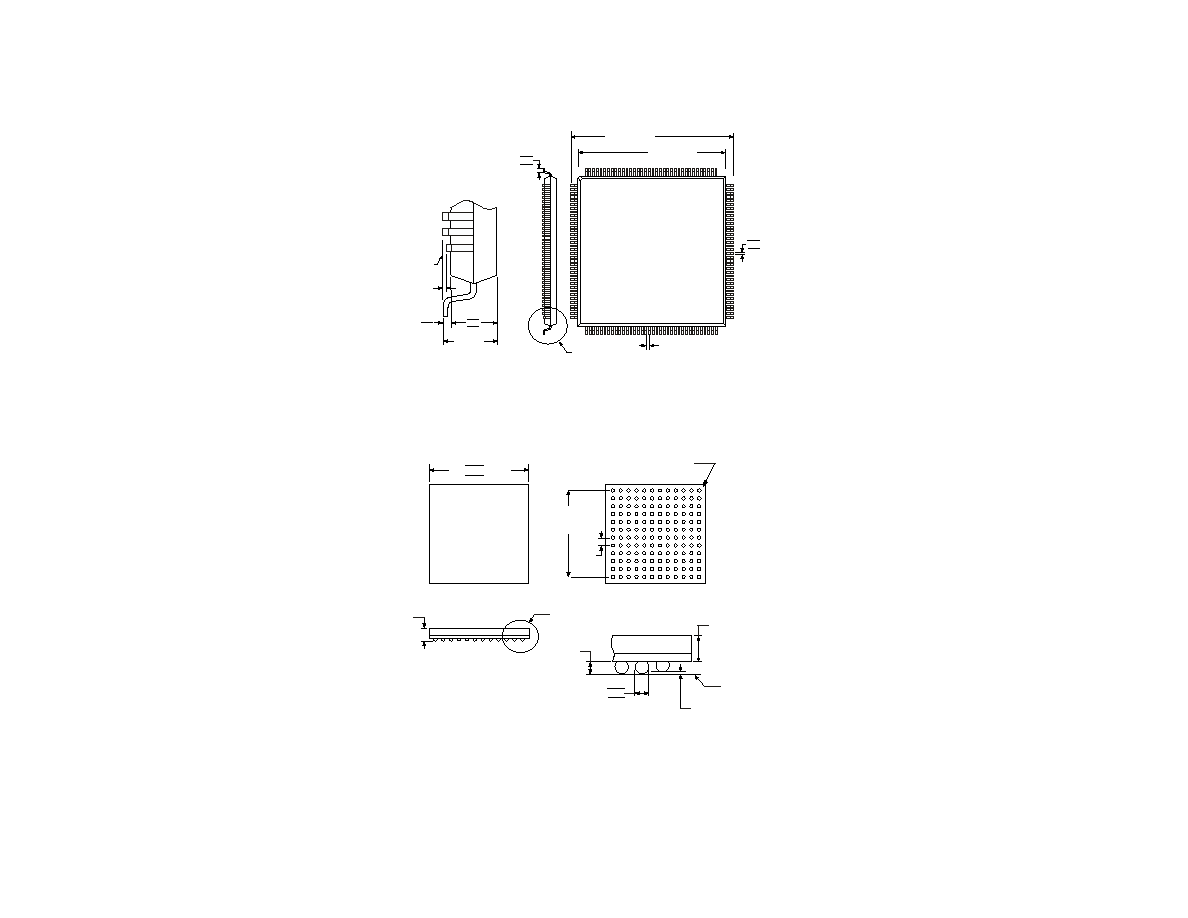
ADSP-2191M
48
REV. 0
OUTLINE DIMENSIONS
144-LEAD METRIC THIN PLASTIC QUAD FLATPACK (LQFP) (ST-144)
144-BALL MINI-BGA (CA-144A)
SEATING
PLANE
1.60 MAX
0.15
0.05
0.08 MAX LEAD
COPLANARITY
0.75
0.60
0.45
1.45
1.40
1.35
1
3 6
37
73
72
108
144
109
TOP VIEW (PINS DOWN)
22.00 BSC SQ
20.00 BSC SQ
0.50 BSC
LEAD PITCH
0.27
0.22
0.17
TYP
DIMENSIONS IN MILLIMETERS.
ACTUAL POSITION OF EACH LEAD IS WITHIN 0.08 OF ITS
IDEAL POSITION, WHEN MEASURED IN THE LATERAL DIRECTION.
CENTER DIMENSIONS ARE NOMINAL.
NOTES:
3.
2.
1.
DETAIL A
DETAIL A
SEATING
PLANE
0.85
MIN
0.25
MIN
DIMENSIONS IN MILLIMETERS.
ACTUAL POSITION OF THE BALL GRID IS
WITHIN 0.15 OF ITS IDEAL POSITION, RELATIVE TO
THE PACKAGE EDGES.
ACTUAL POSITION OF EACH BALL IS WITHIN 0.08
OF ITS IDEAL POSITION, RELATIVE TO THE BALL
GRID.
CENTER DIMENSIONS ARE NOMINAL.
NOTES:
3.
4.
1.
2.
DETAIL A
0.55
0.50
0.45
BALL
DIAMETER
0.10 MAX BALL
COPLANARITY
1.70
MAX
DETAIL A
8.80
BSC
SQ
0.80
BSC
BALL
PITCH
A
B
C
D
E
F
G
H
J
K
L
M
12 11 10 9 8 7 6 5 4 3 2 1
10.10
10.00 SQ
9.90
BOTTOM VIEW
TOP VIEW
A1 COR NER INDE X
T RIANG LE

49
REV. 0
ADSP-2191M
ORDERING GUIDE
Part Number
1, 2
1
ST = Plastic Thin Quad Flatpack (LQFP).
2
CA = Mini Ball Grid Array
Ambient Temperature Range
Instruction
Rate (MHz)
Package
Description
Operating Voltage
ADSP-2191MKST-160
0ºC to 70ºC
160
144-Lead LQFP
2.5 Int./3.3 Ext. V
ADSP-2191MBST-140
40ºC to + 85ºC
140
144-Lead LQFP
2.5 Int./3.3 Ext. V
ADSP-2191MKCA-160
0ºC to 70ºC
160
144-Ball Mini-BGA 2.5 Int./3.3 Ext. V
ADSP-2191MBCA-140
40ºC to + 85ºC
140
144-Ball Mini-BGA 2.5 Int./3.3 Ext. V

ADSP-2191M
50
REV. 0

51
REV. 0
ADSP-2191M

ADSP-2191M
52
RE
V. 0
PRINTED IN U.S.A.
C02936-0-4/02(0)
Document Outline
- Specifications
- ELECTRICAL CHARACTERISTICS
- Pinout
- Package drawings
- Ordering Guide
- Features
- Product Description
- Absolute Maximum Ratings
- Functional Block Diagram
- Pin Function Description
- Circuit Information
- TABLE OF CONTENTS
- ESD SENSITIVITY
- LEAD METRIC THIN PLASTIC QUAD FLATPACK (LQFP) (ST-144)
- BALL MINI-BGA (CA-144A)
- DIAGRAMS
- System Diagram
- Memory Map
- External Crystal Connections
- JTAG Target Board Connector with No Local Boundary Scan
- JTAG Target Board Connector for JTAG Equipped Analog Devices DSP (Jumpers in Place)
- JTAG Pod Connector Dimensions
- Clock In and Clock Out Cycle Timing
- Programmable Flags Cycle Timing
- Timer PWM_OUT Cycle Timing
- External Port Write Cycle Timing
- External Port Read Cycle Timing
- External Port Bus Request and Grant Cycle Timing
- Host Port ALE Mode Write Cycle Timing
- Host Port ACC Mode Write Cycle Timing
- Host Port ALE Mode Read Cycle Timing
- Host Port ACC Mode Read Cycle Timing
- Serial Ports
- Serial PortsExternal Late Frame Sync (Frame Sync Setup > 0.5tSCLK)
- Serial PortsExternal Late Frame Sync (Frame Sync Setup < 0.5tHCLK)
- Serial Peripheral Interface (SPI) PortMaster Timing
- Serial Peripheral Interface (SPI) PortSlave Timing
- UART PortReceive and Transmit Timing
- JTAG Port Timing
- Output Enable/Disable
- Voltage Reference Levels for AC Measurements (Except Output Enable/Disable)



















































